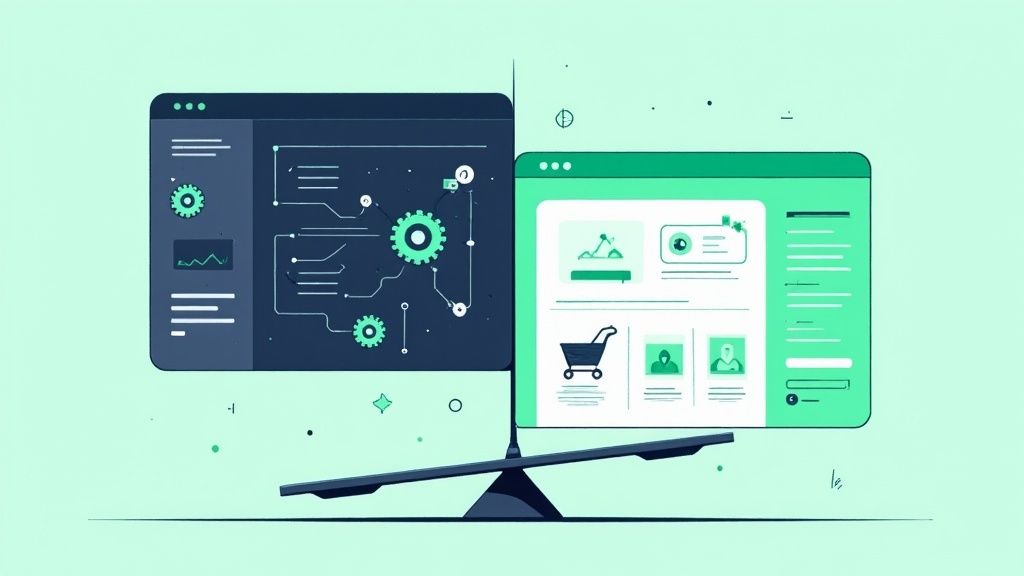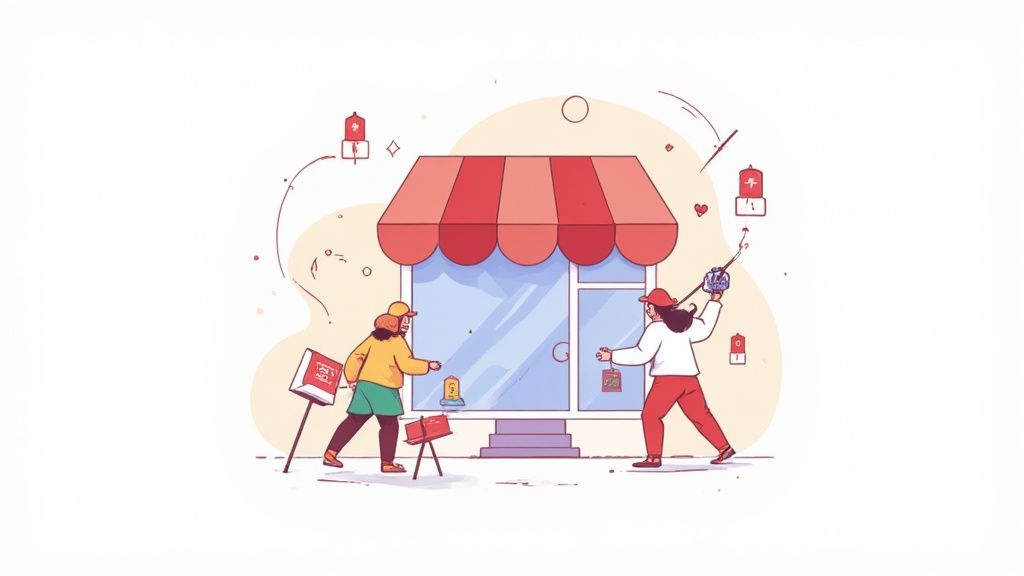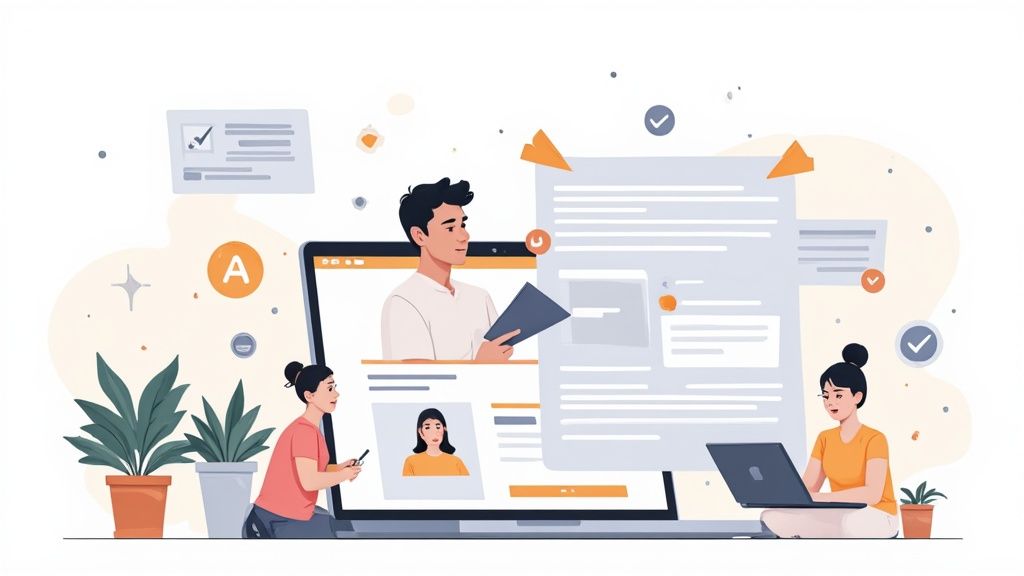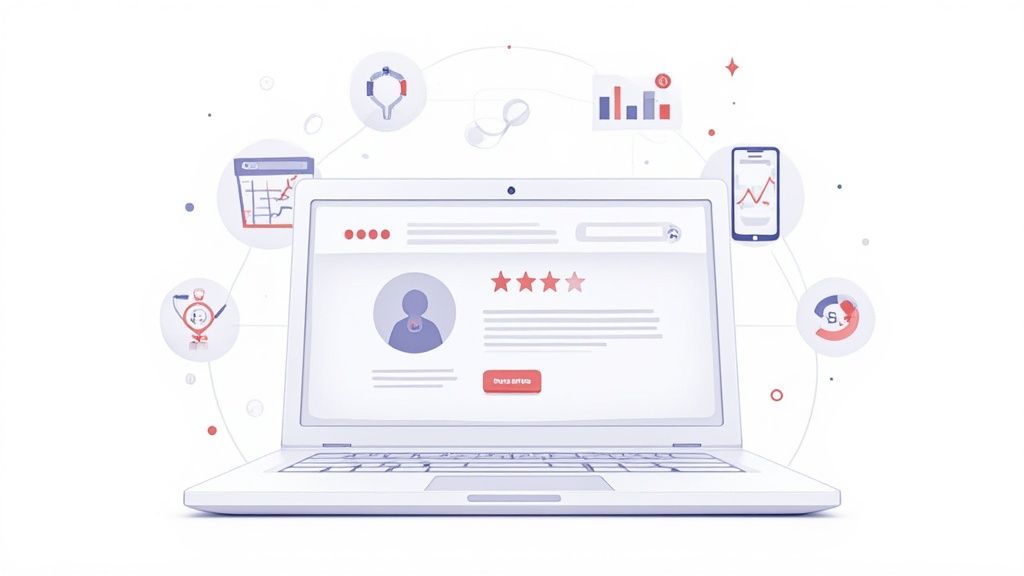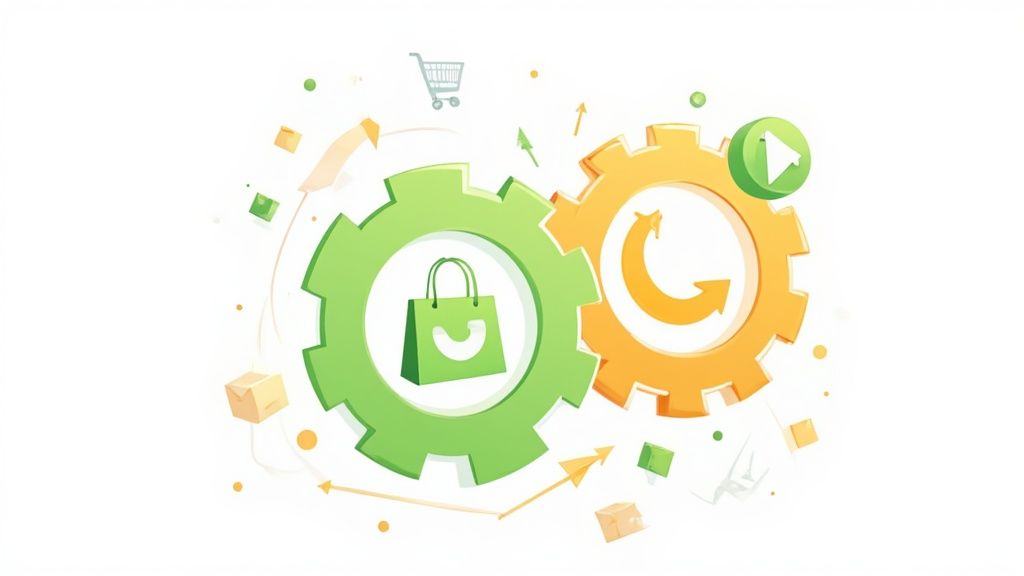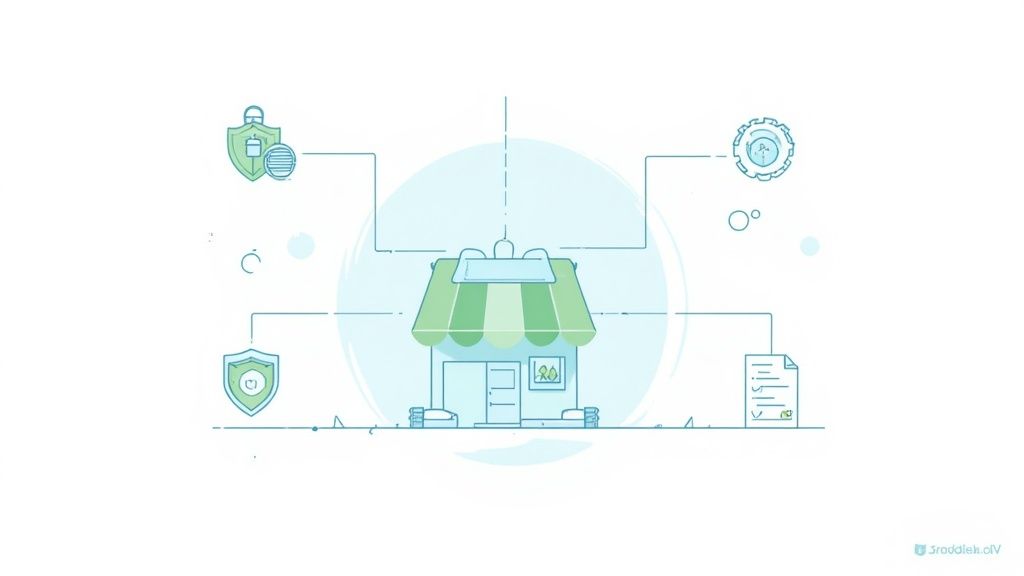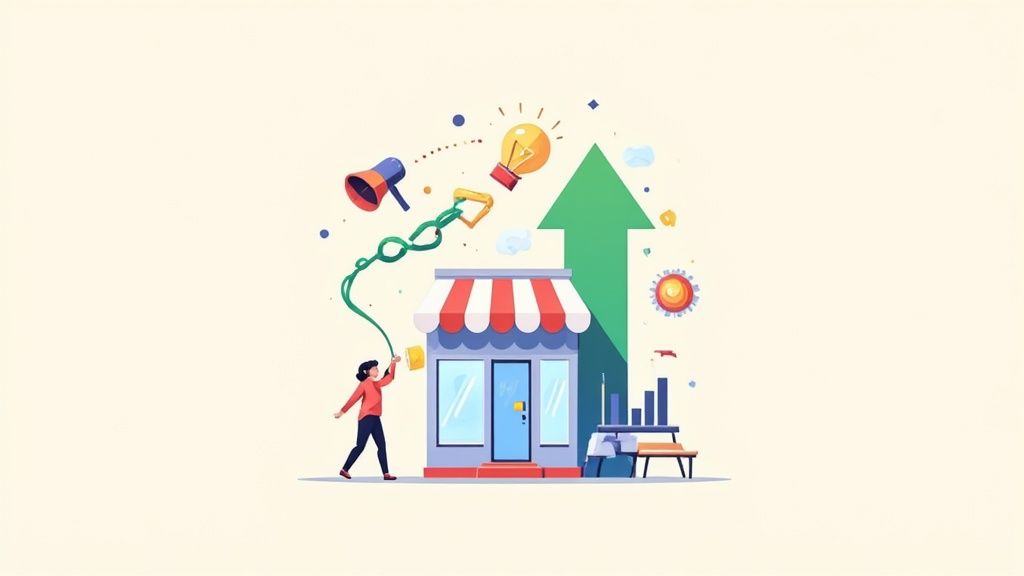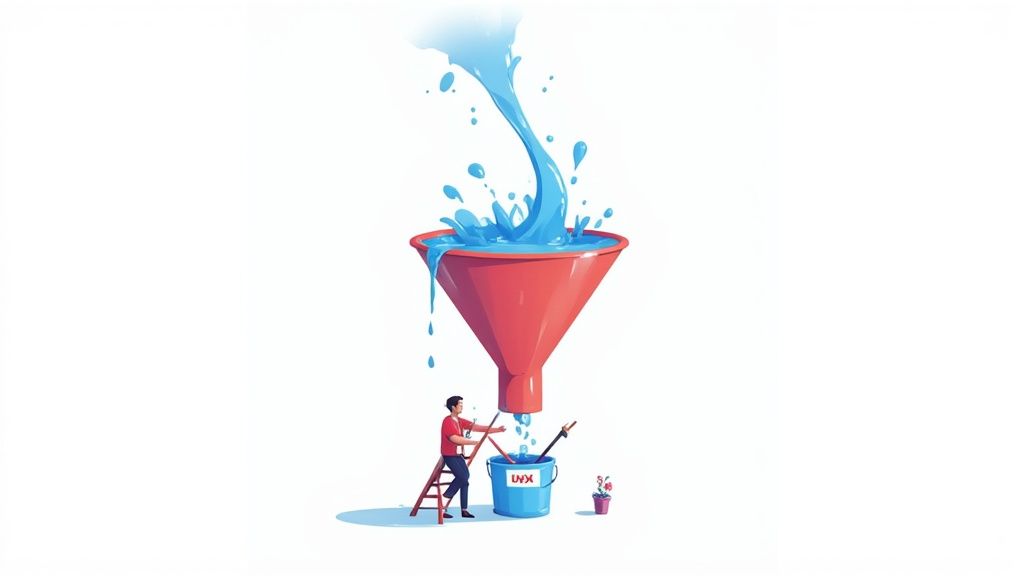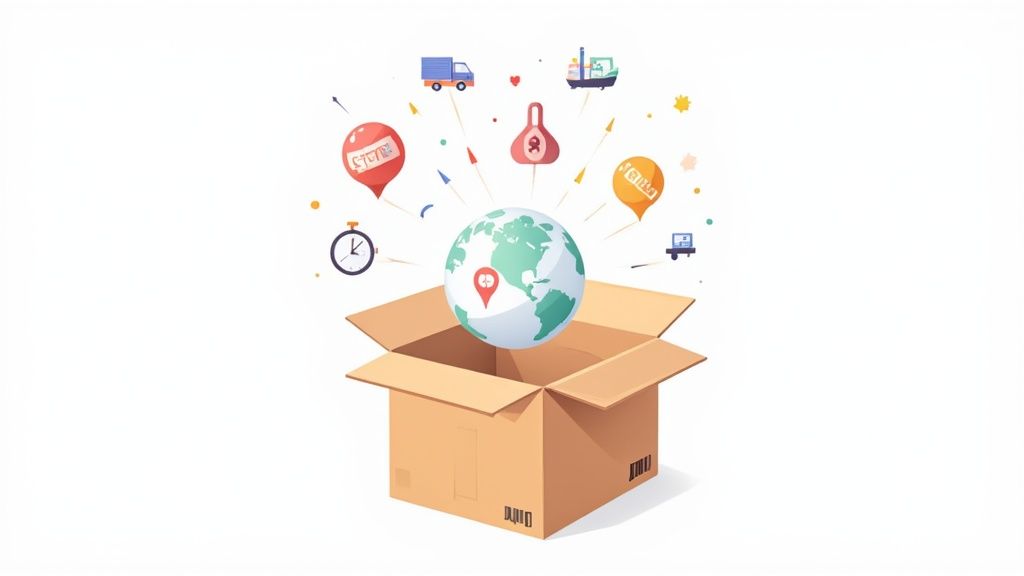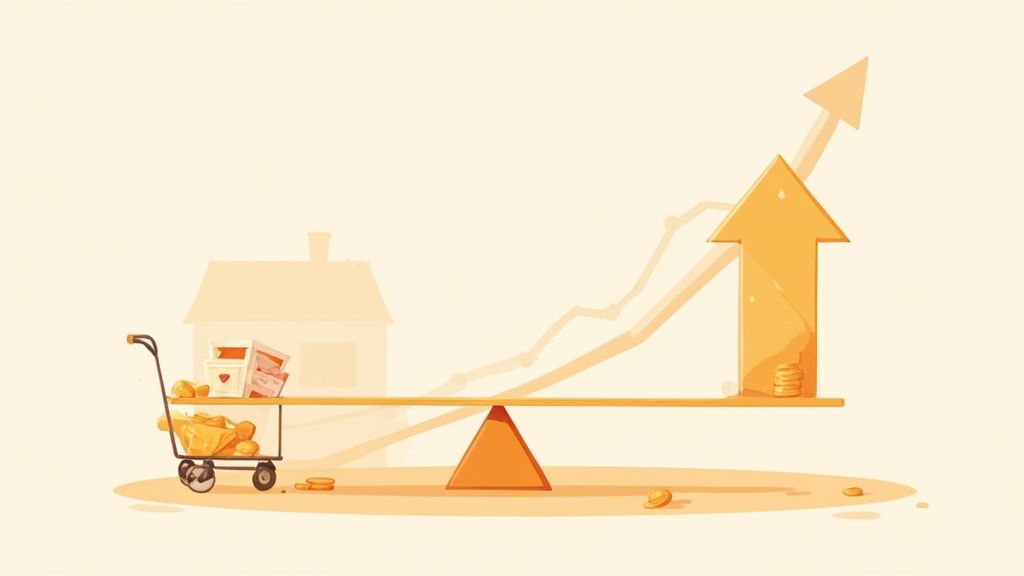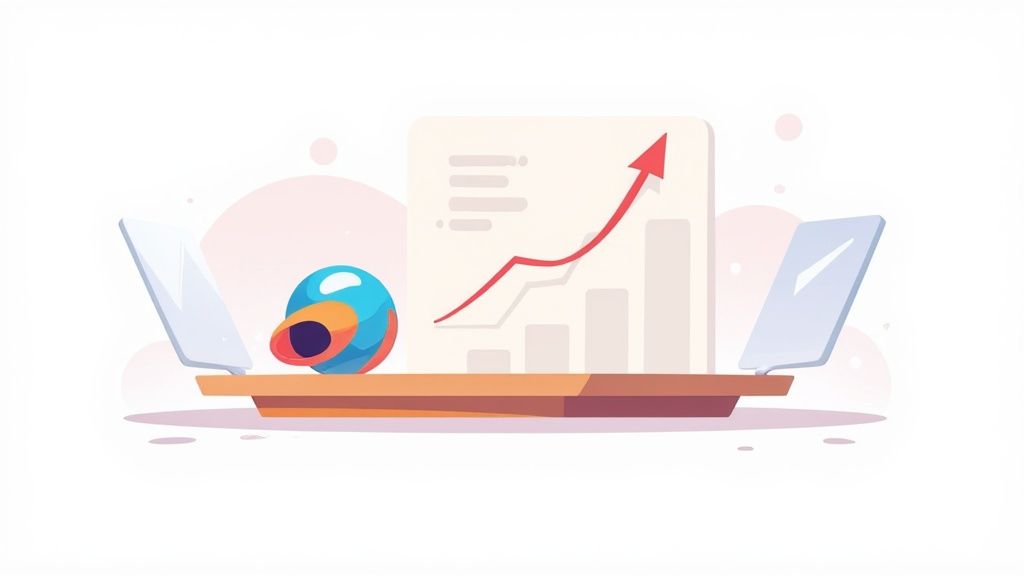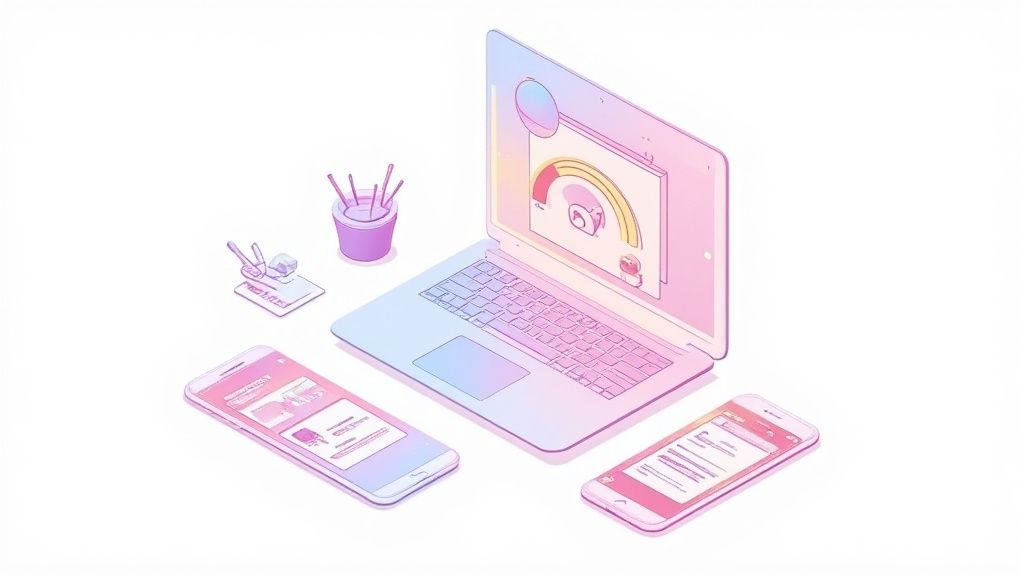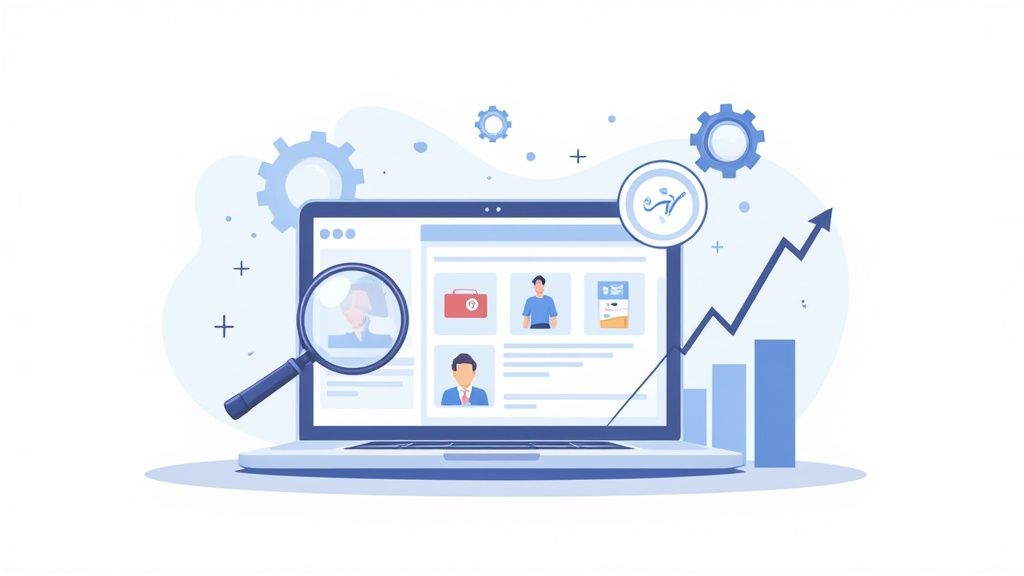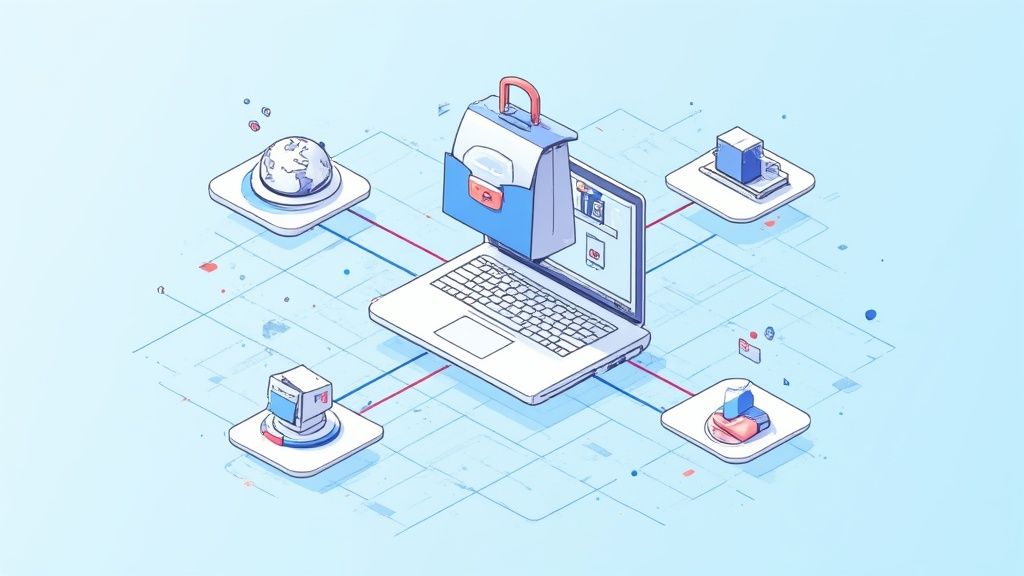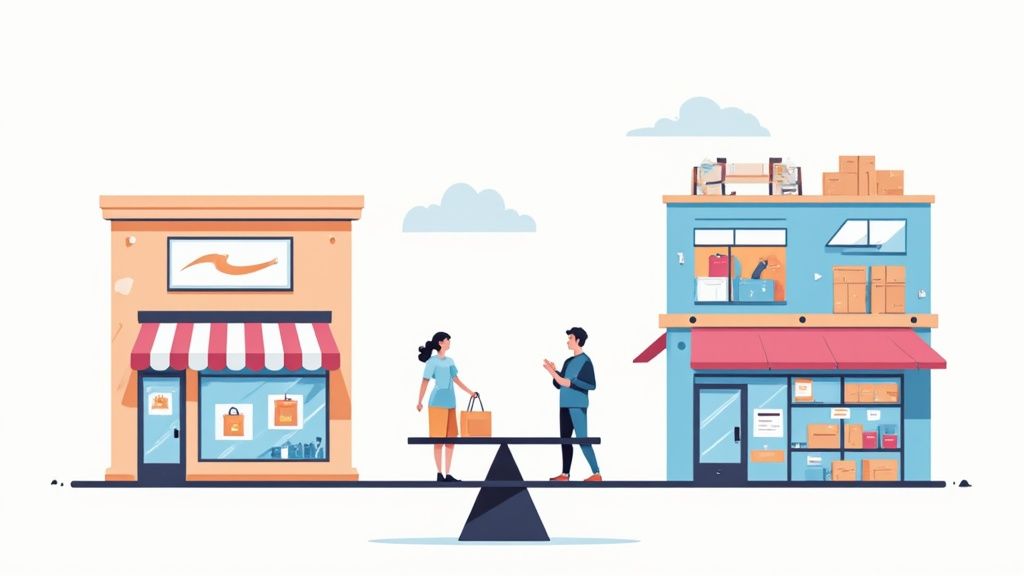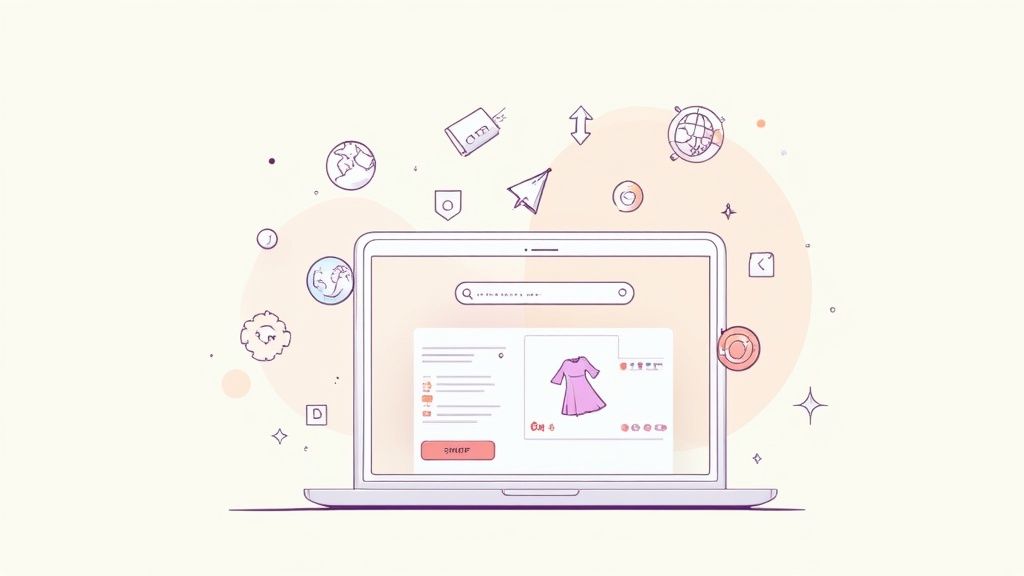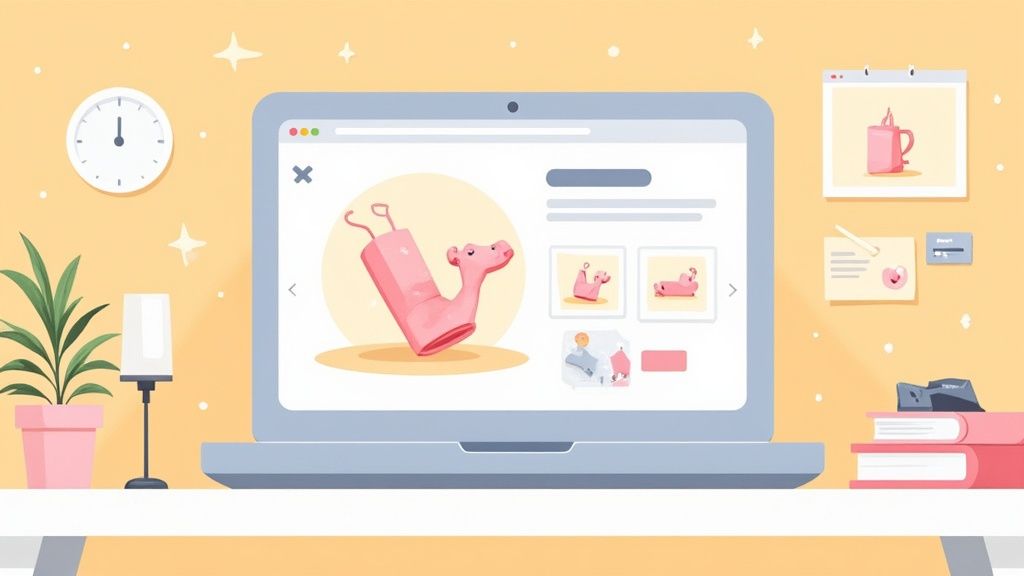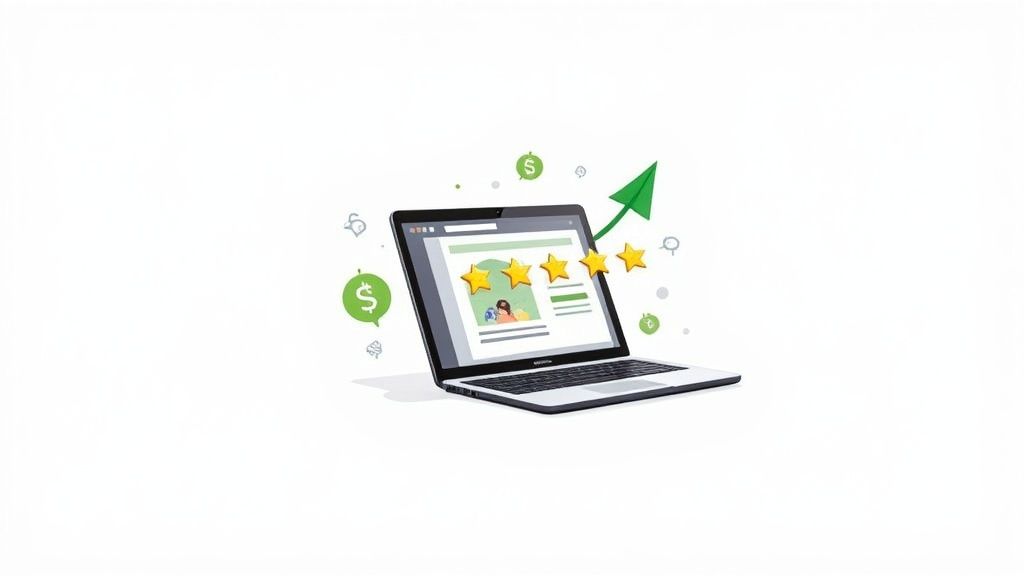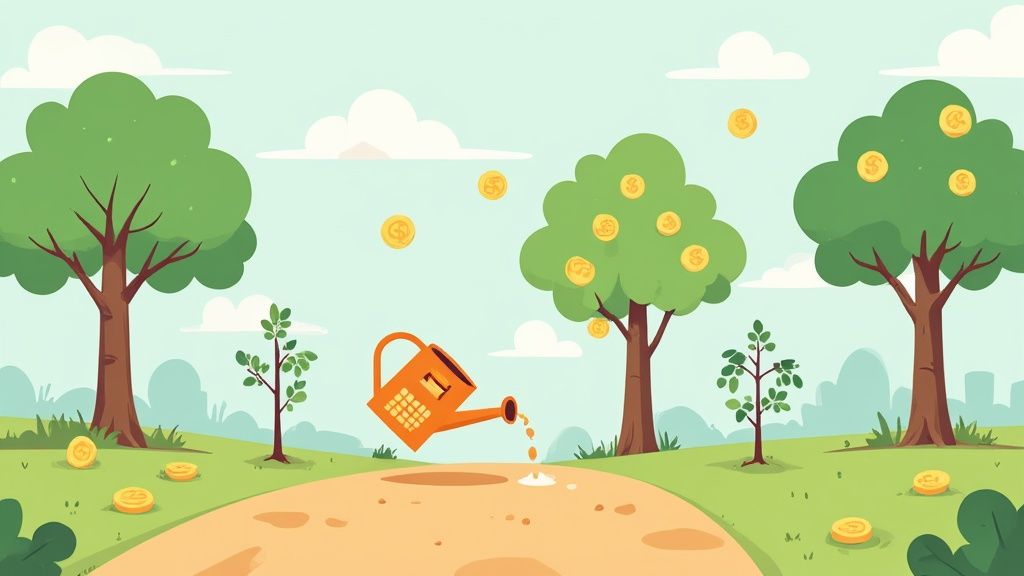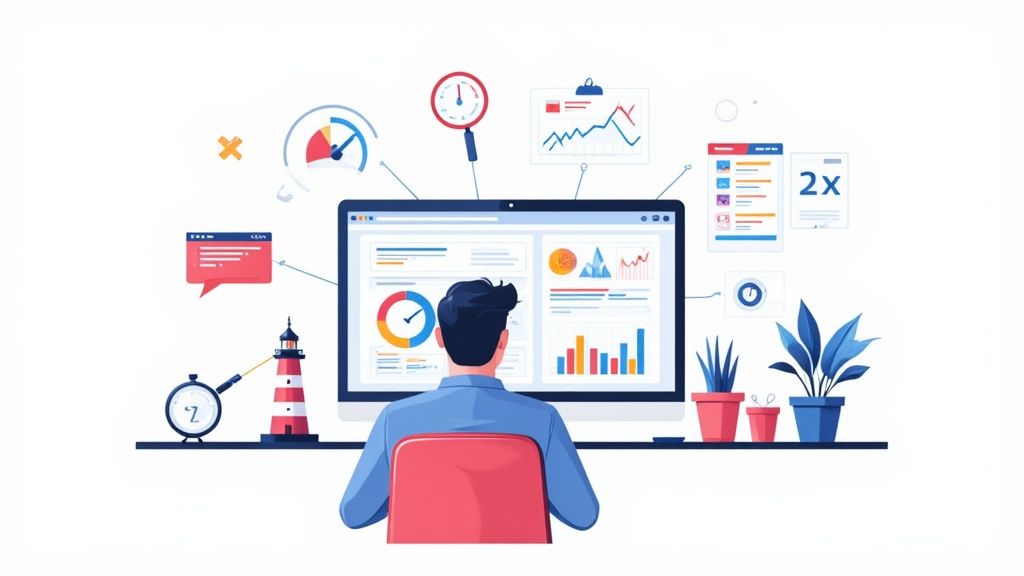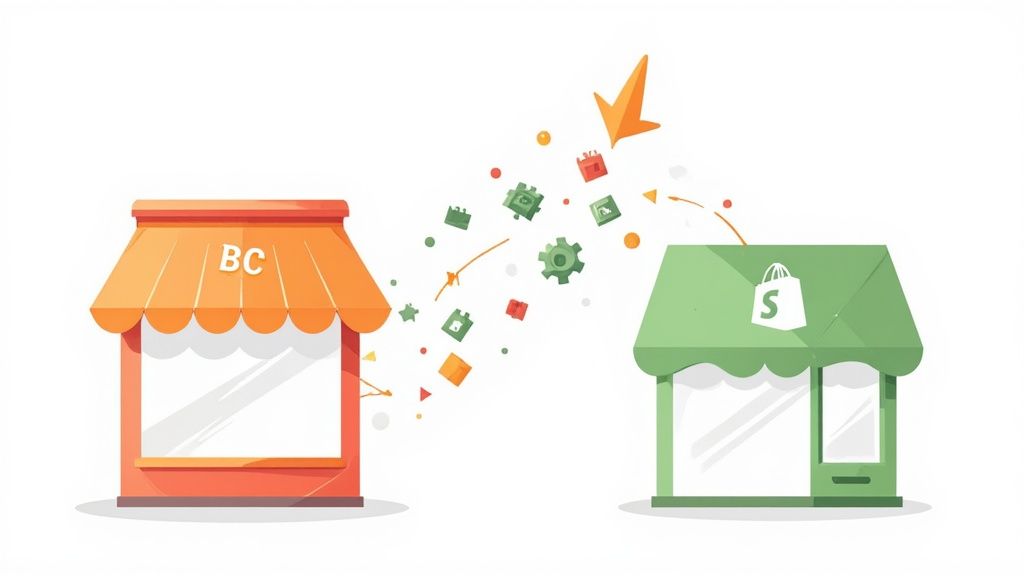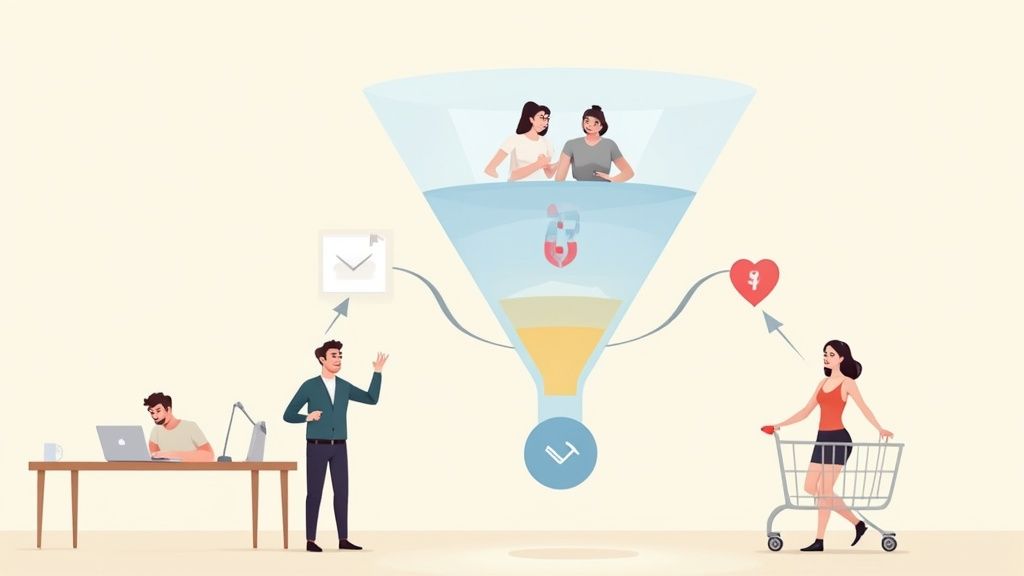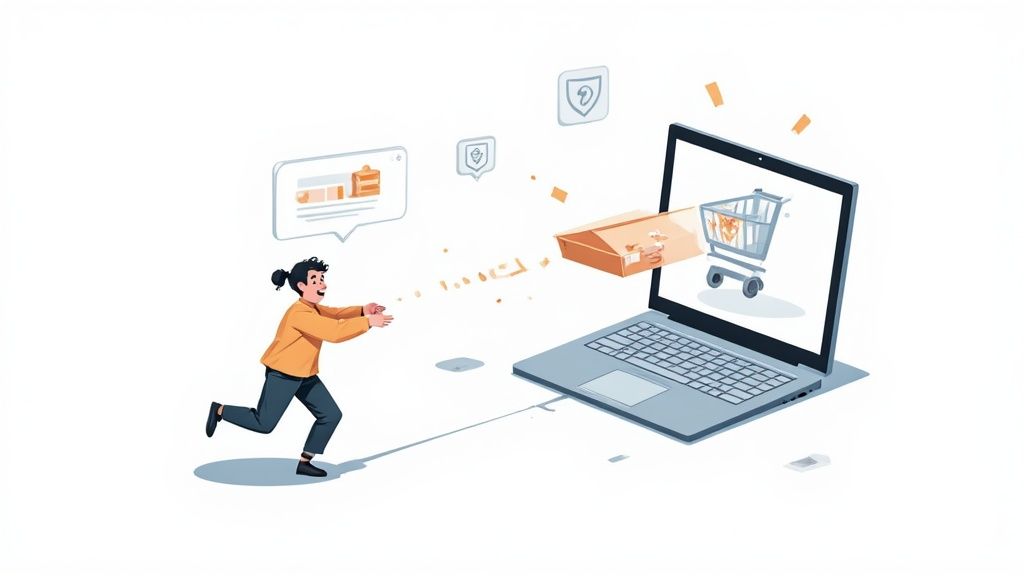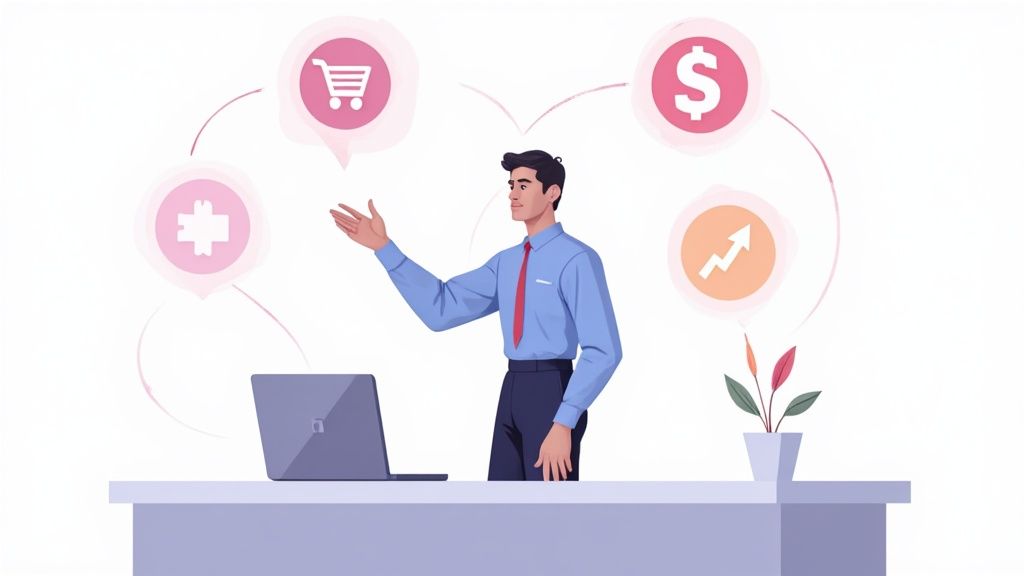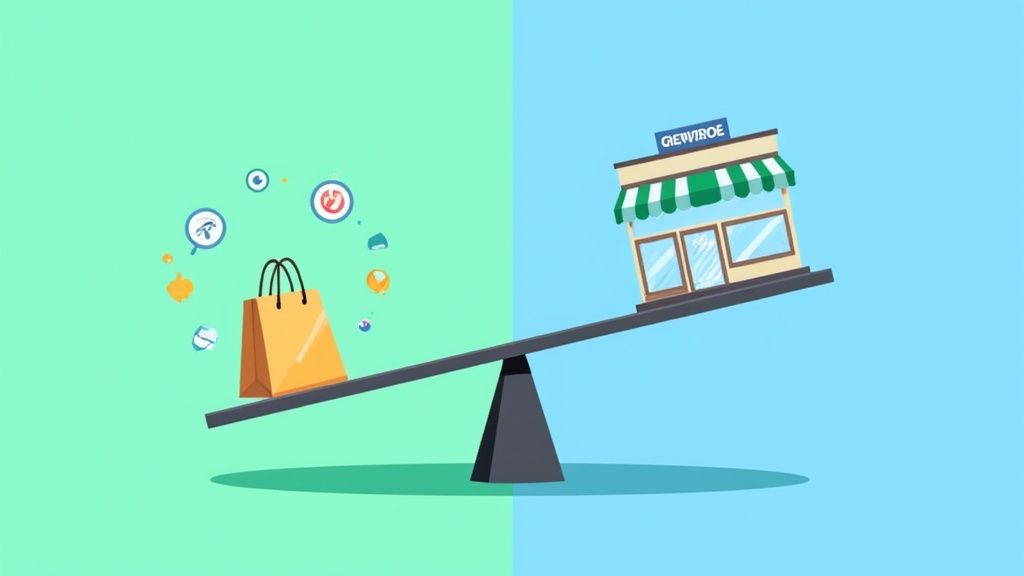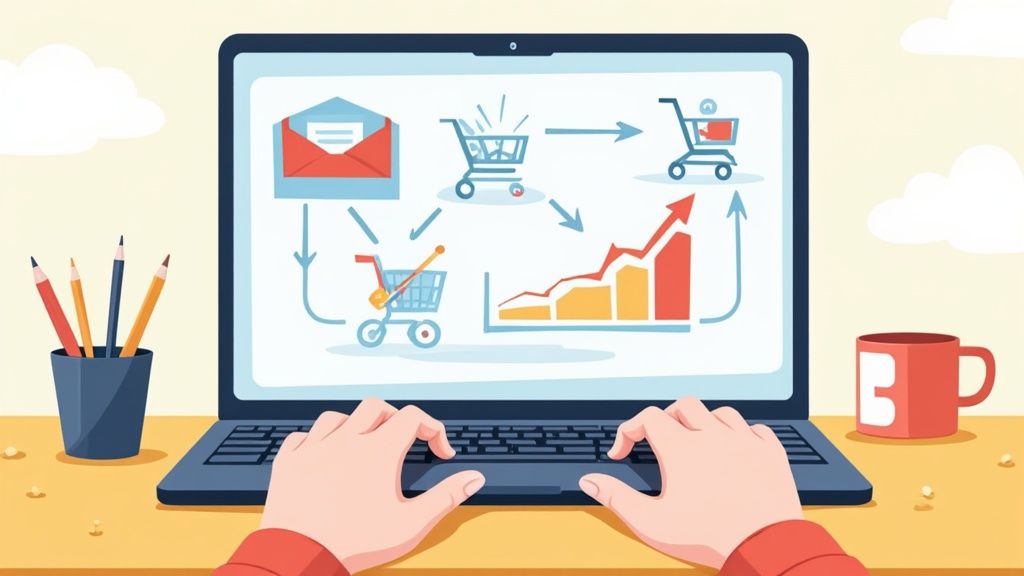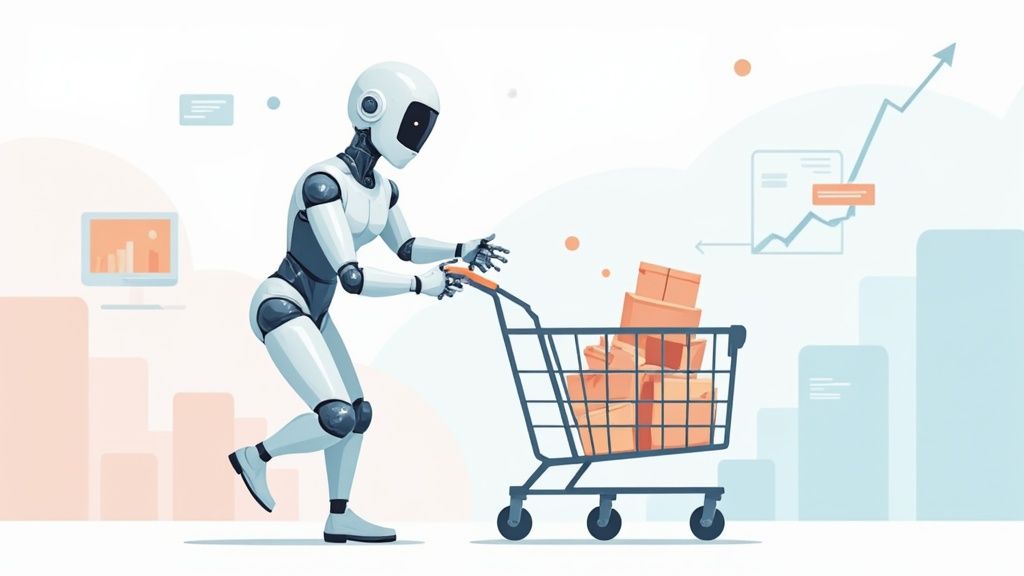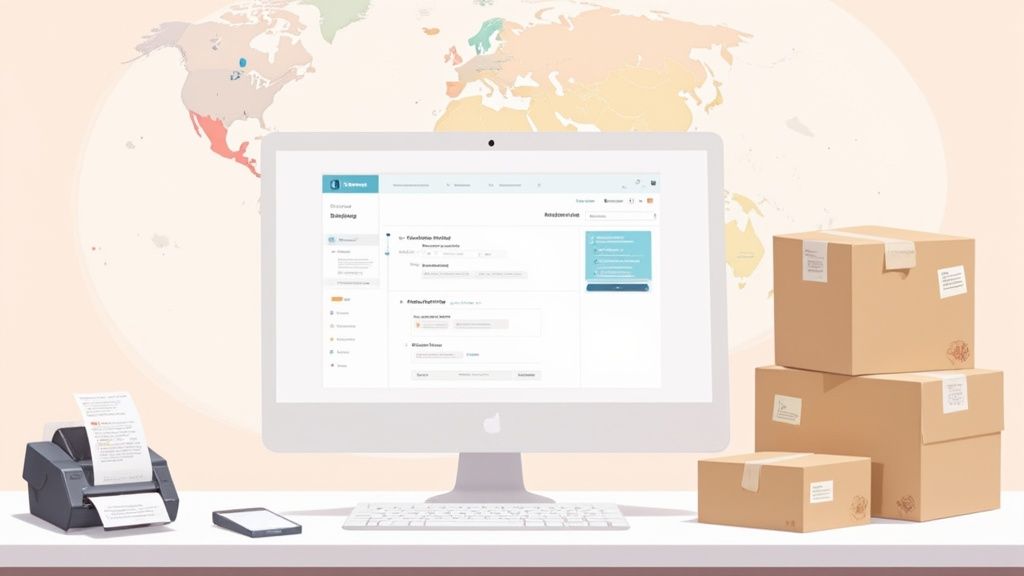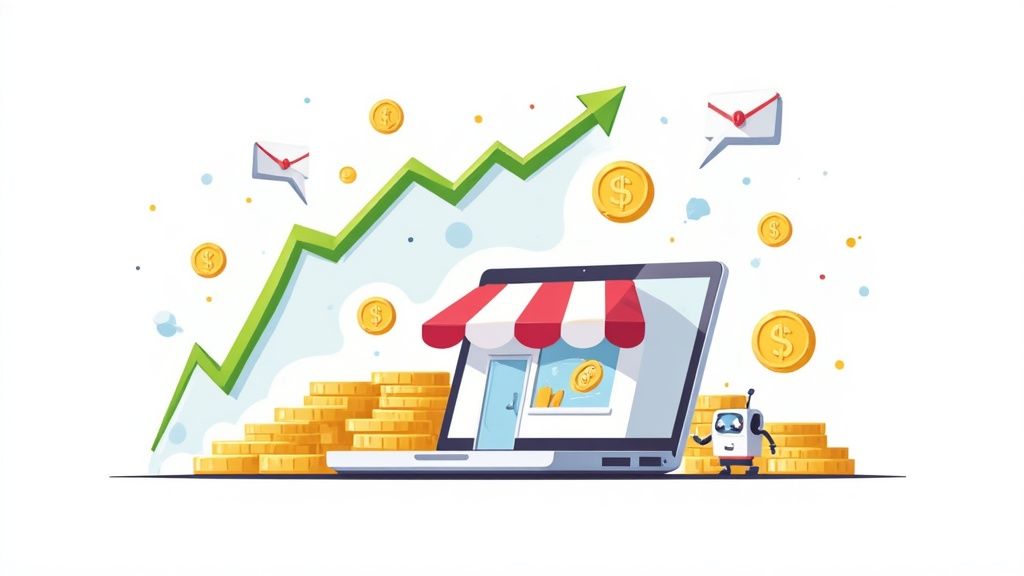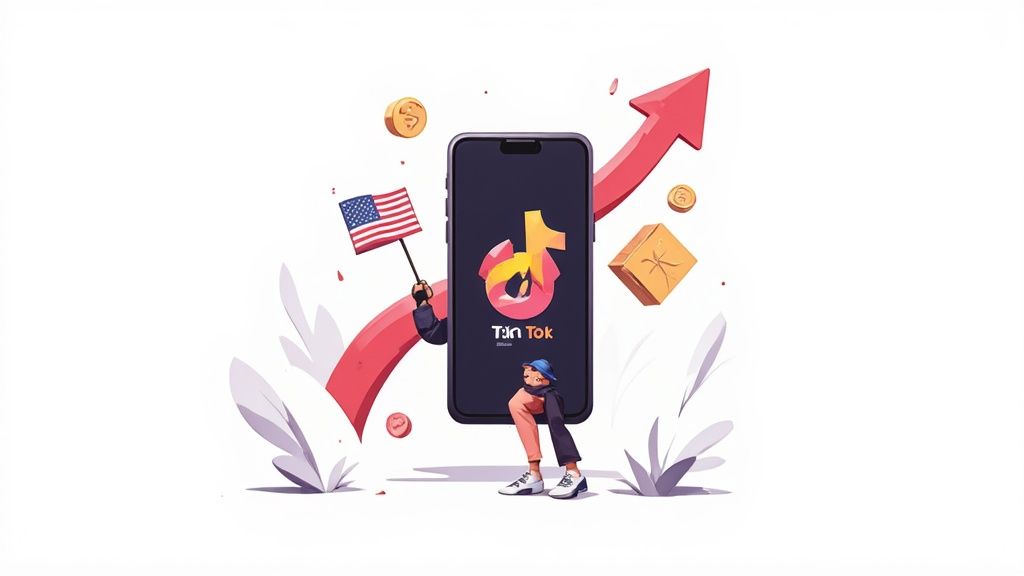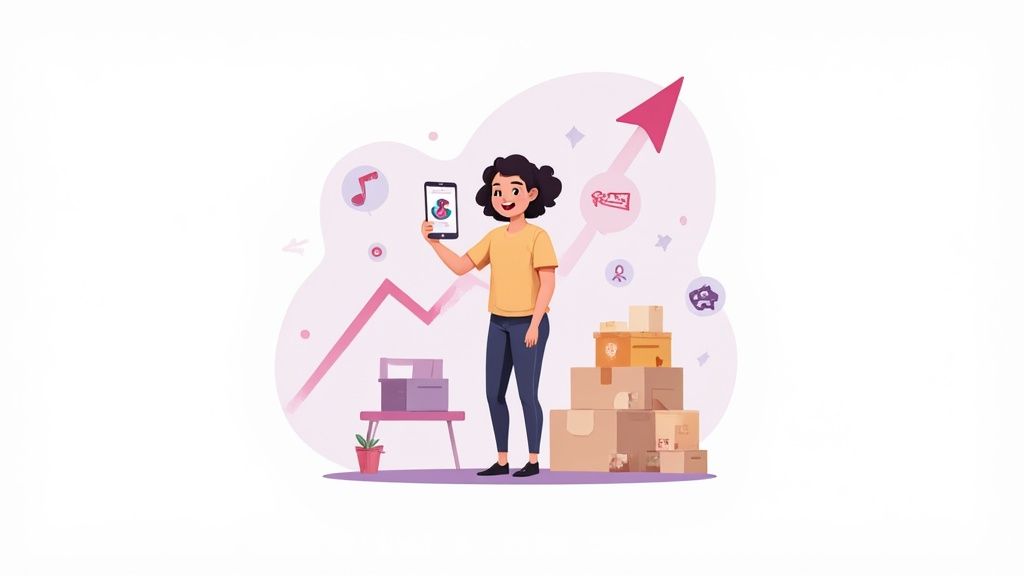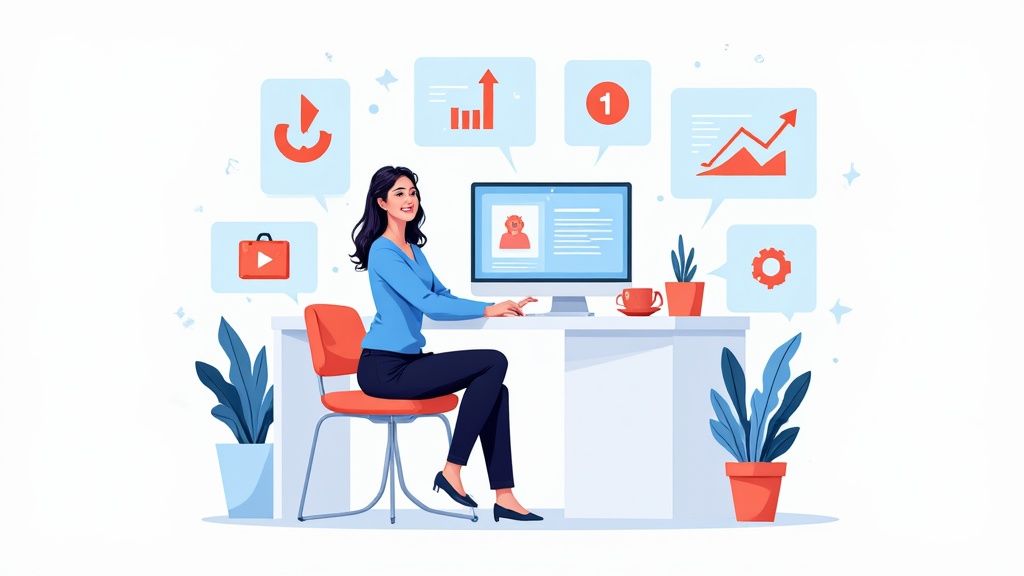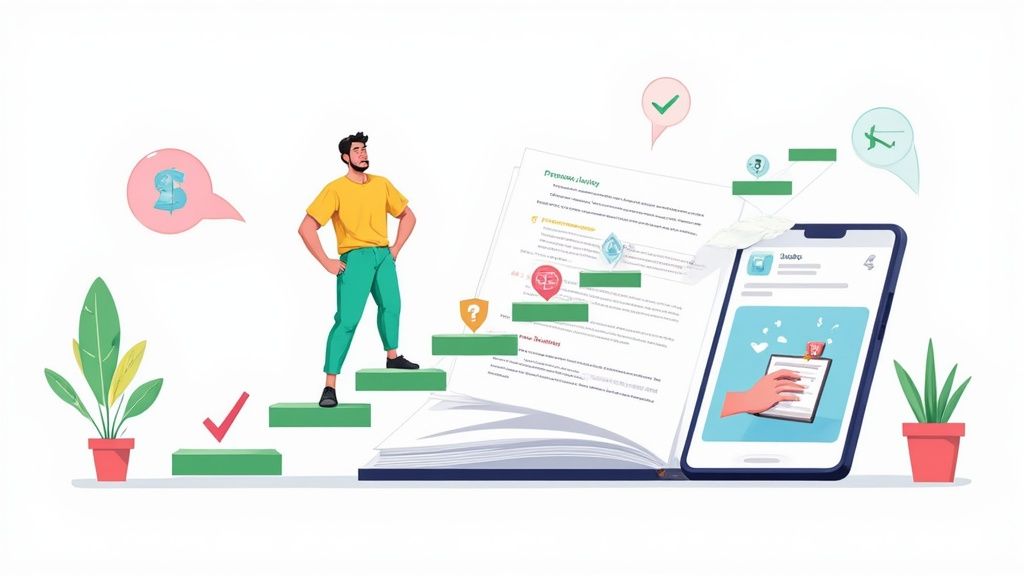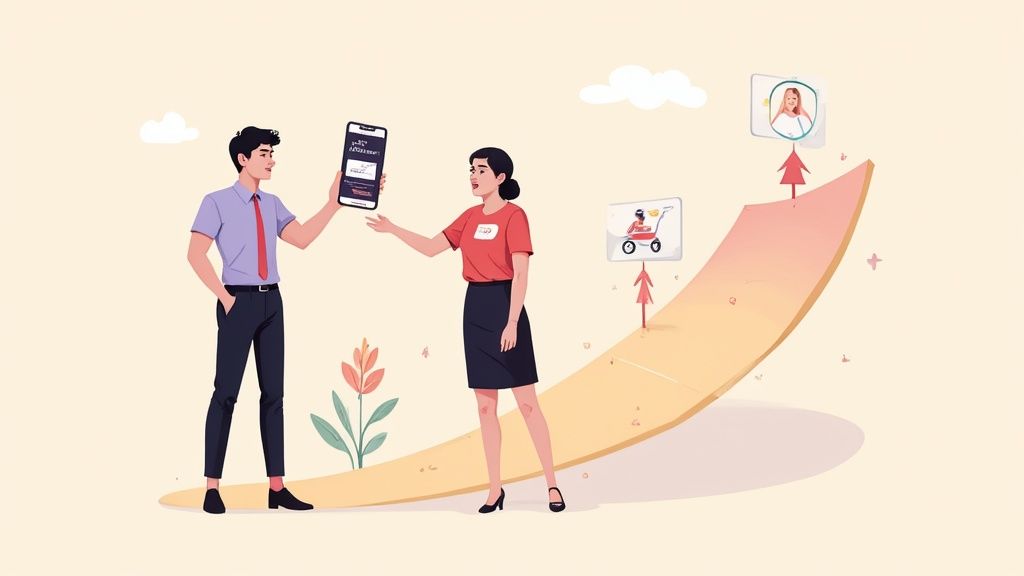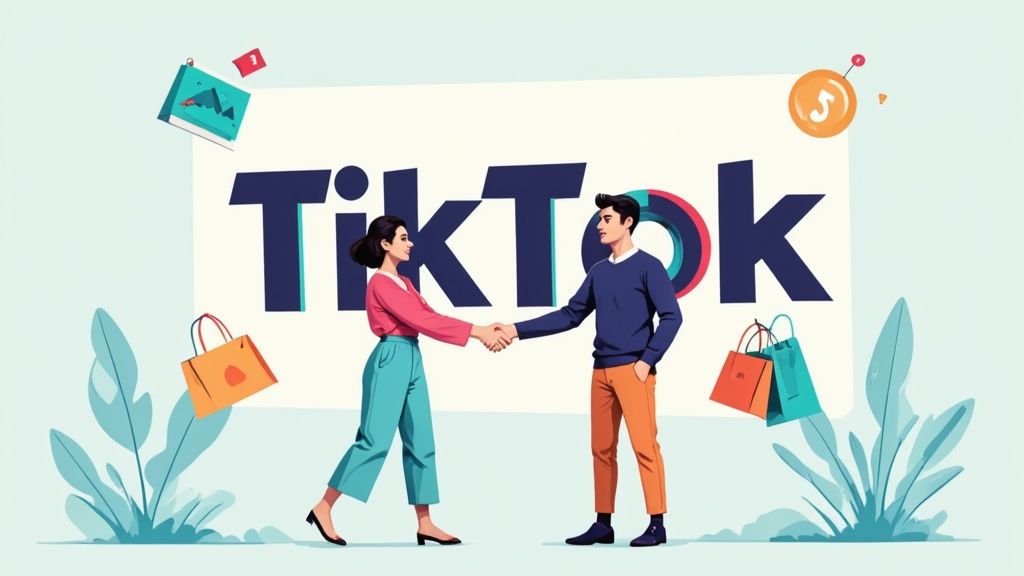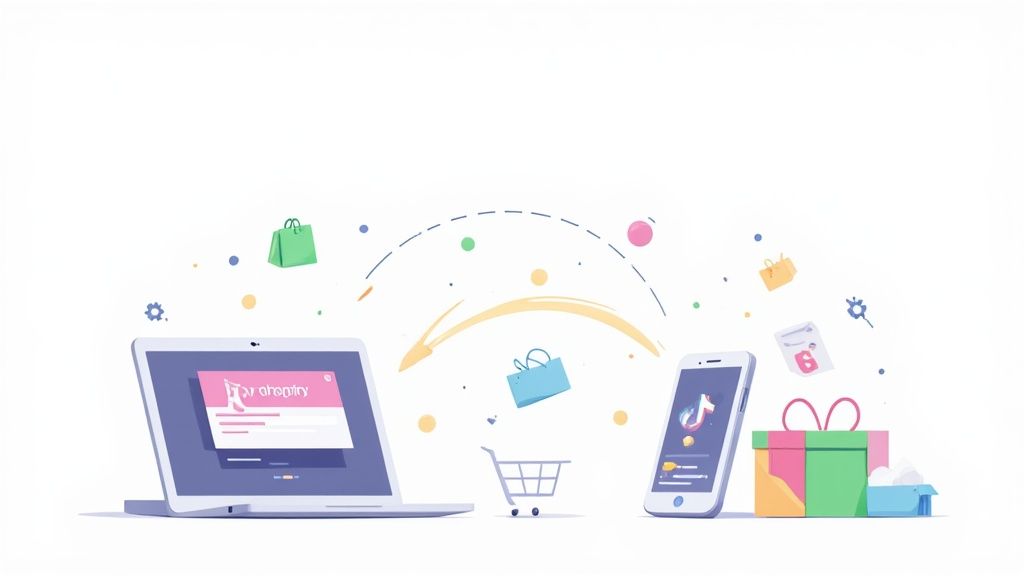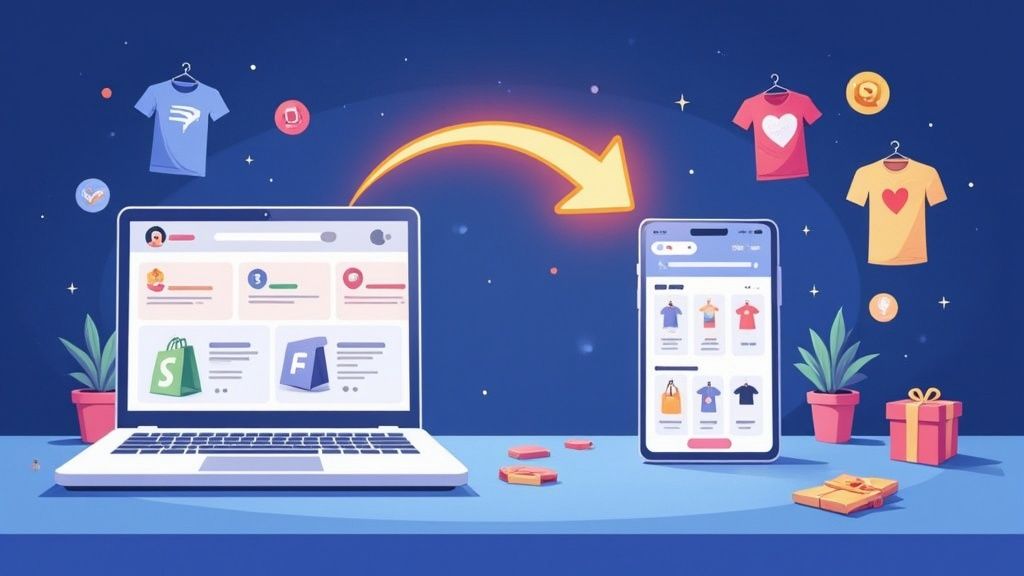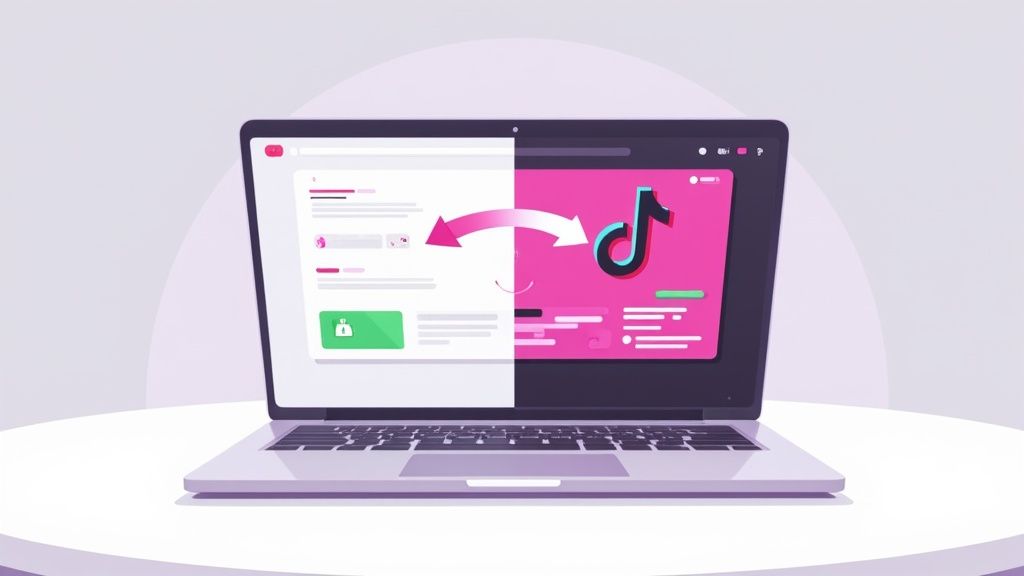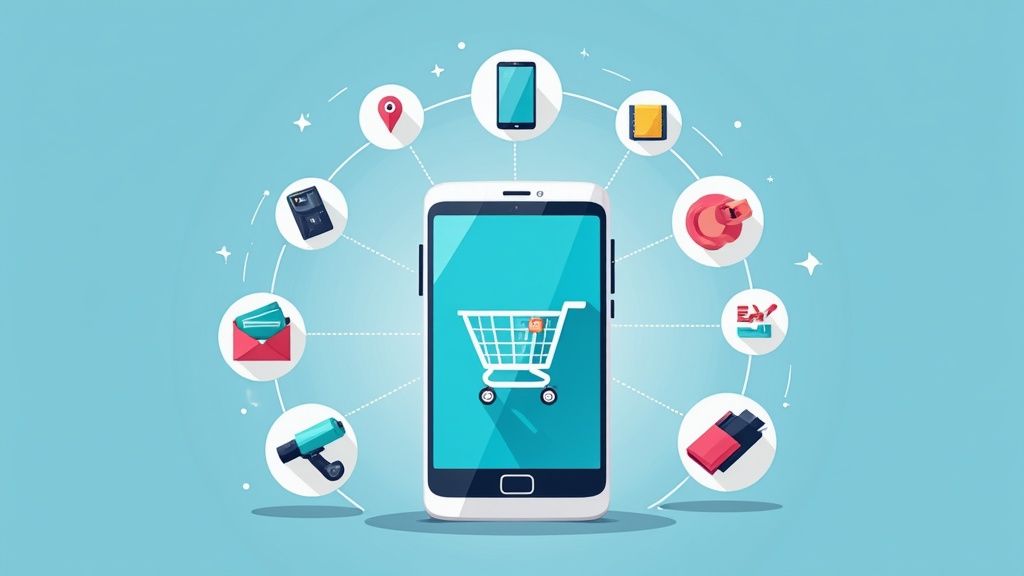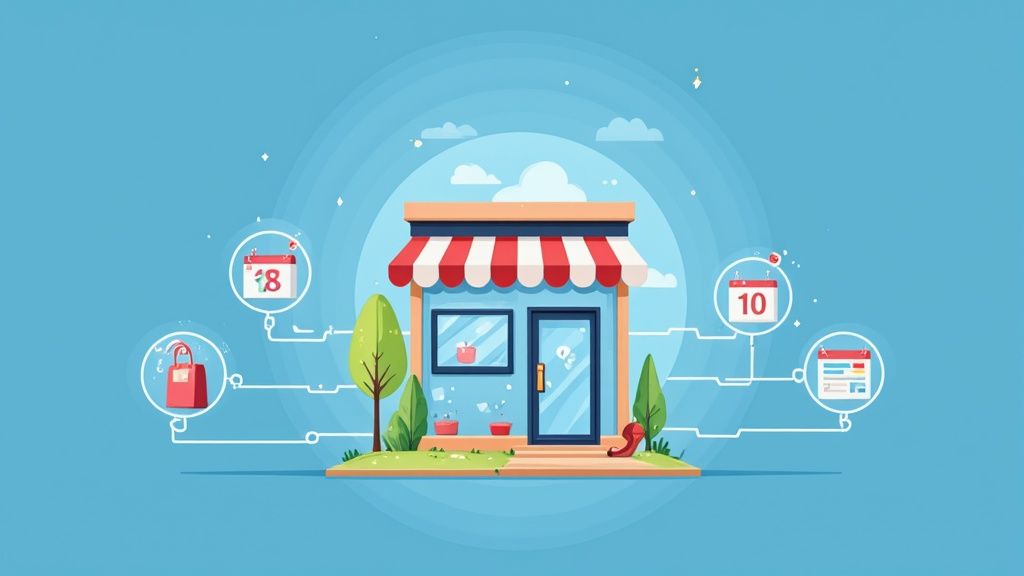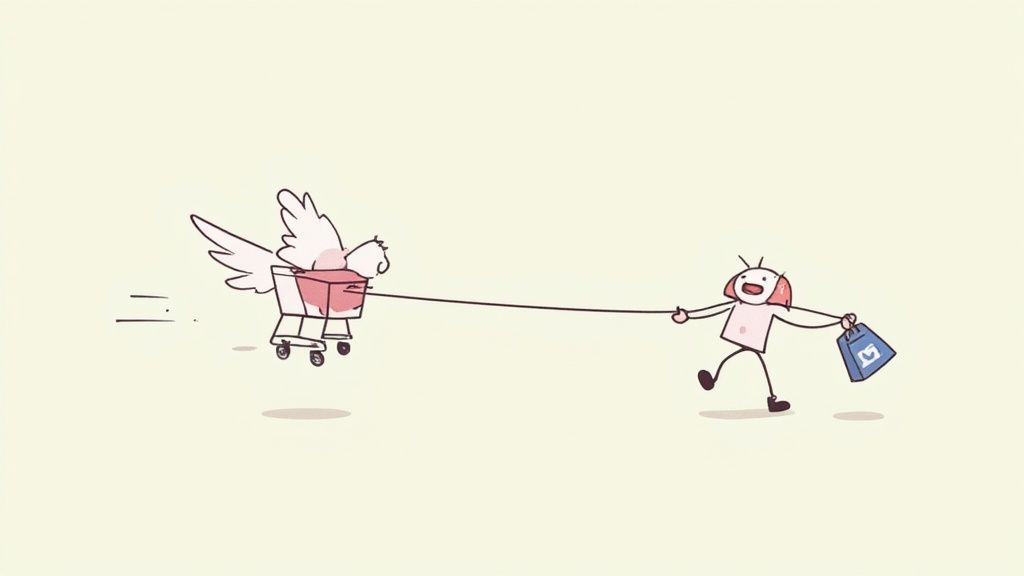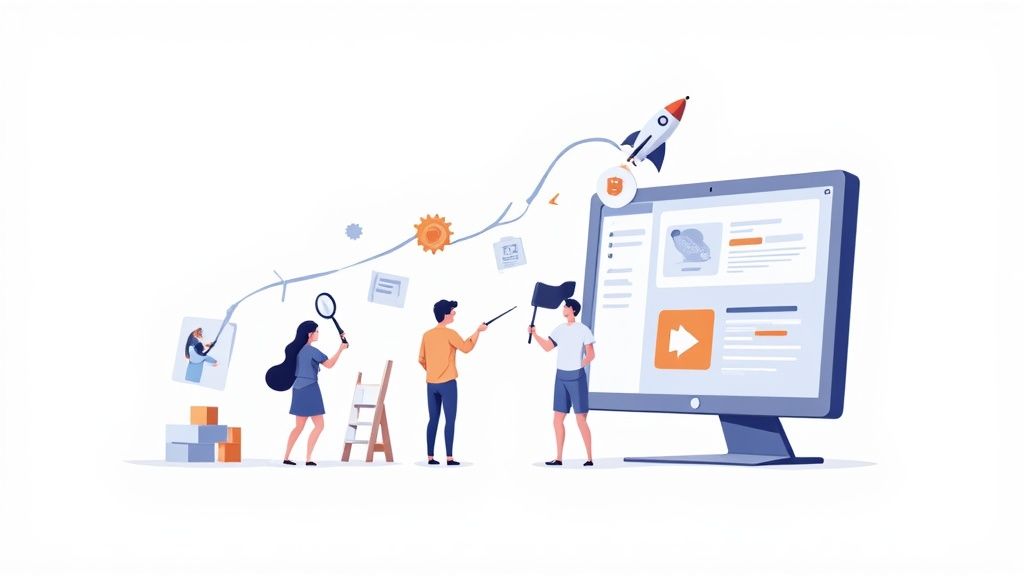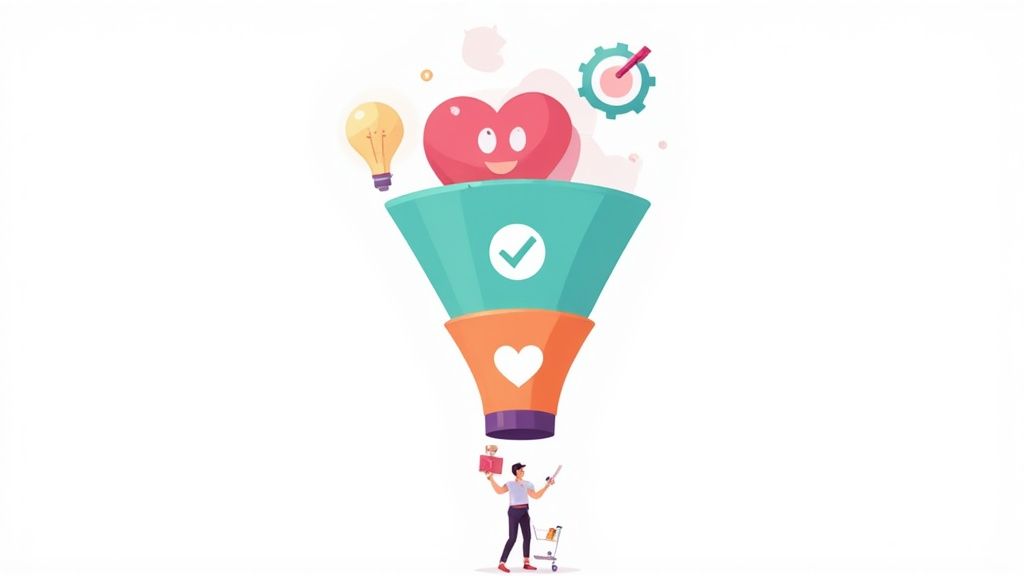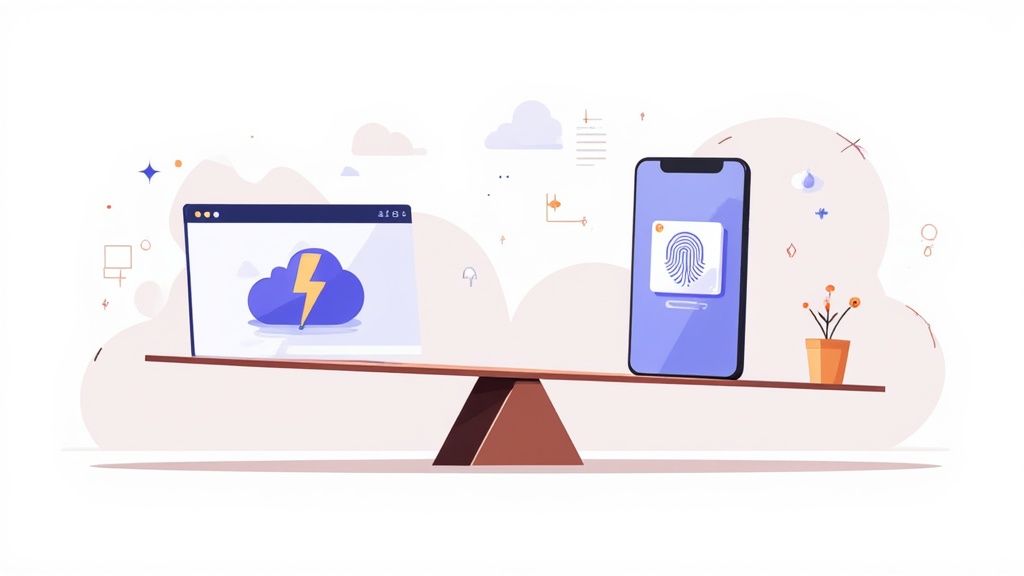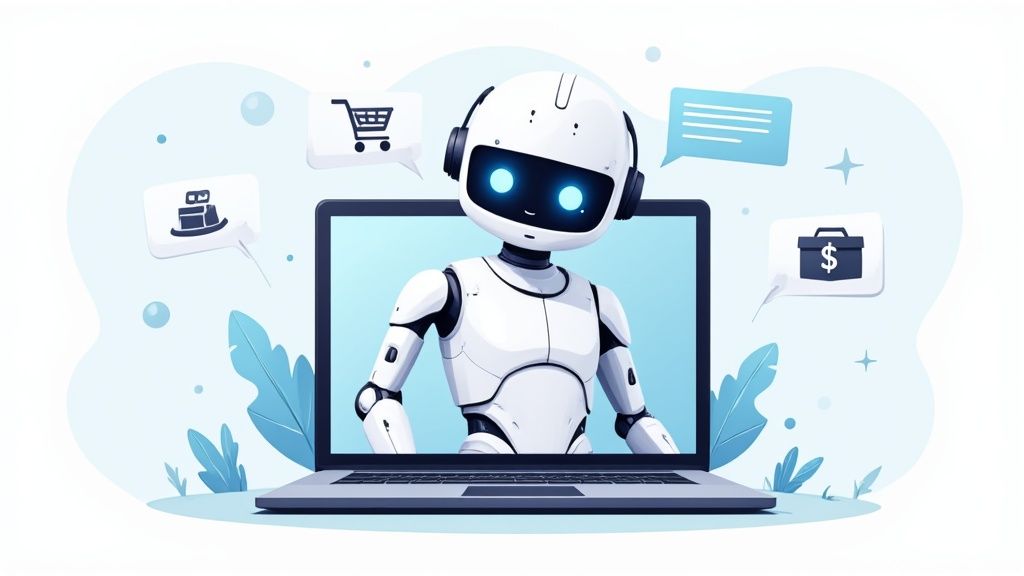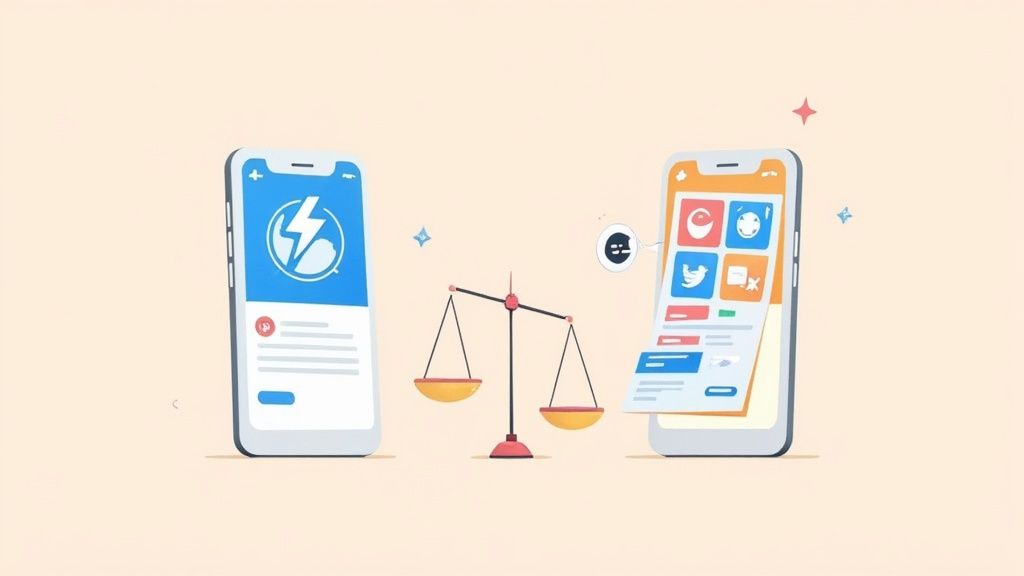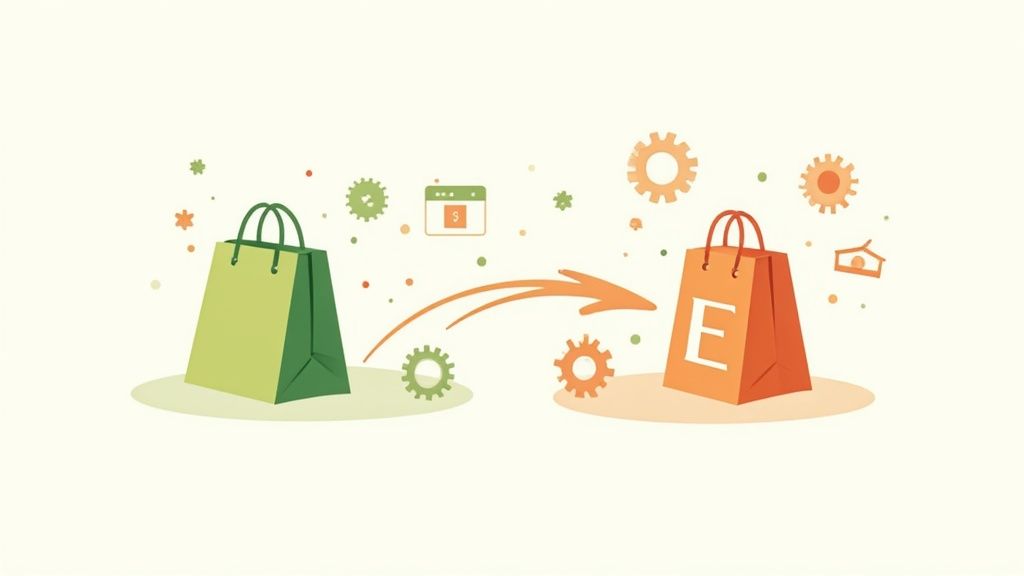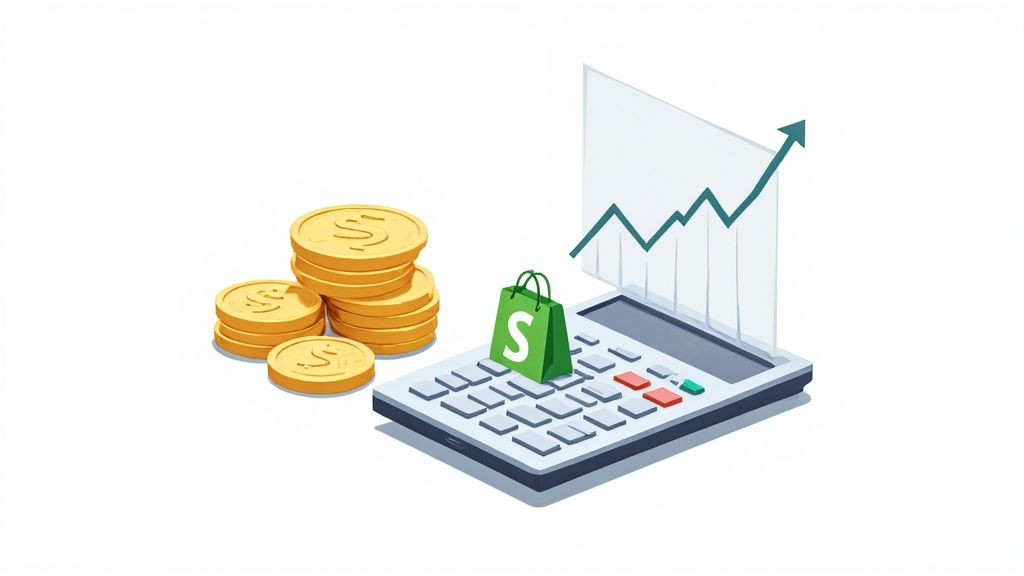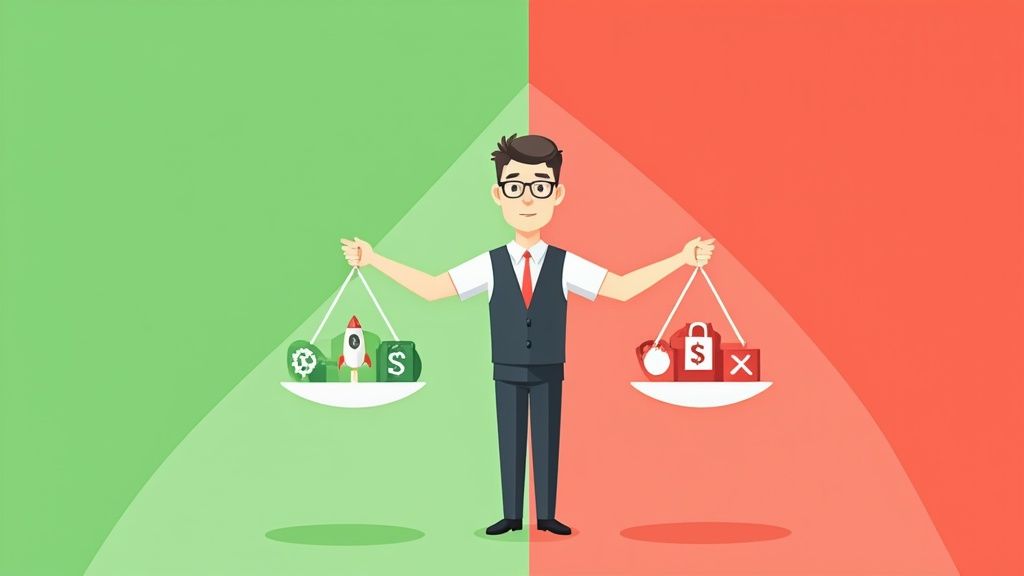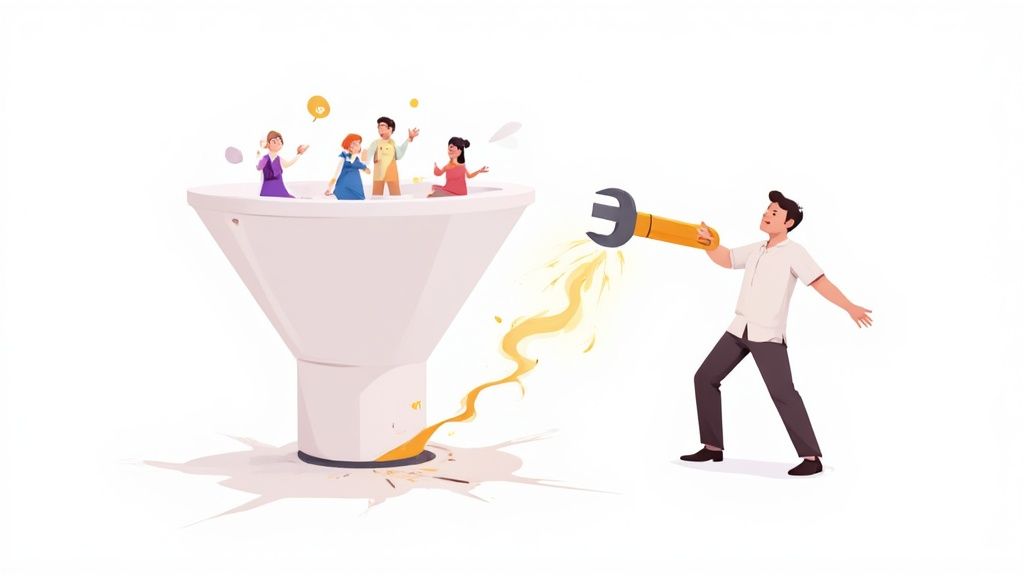
Tackling customer churn isn't about one magic fix. It’s a three-part cycle: first, you have to understand why customers are walking away. Then, you act on that knowledge with smart retention tactics. Finally, you measure what's working to keep refining your strategy.
It's a loop—listen, improve, and consistently prove your value. That's how you keep the customers you've worked so hard to win.
Why Your Best Customers Are Leaving
Before you can stop customers from leaving, you need a solid grasp of why it’s happening in the first place. Churn is more than just a metric; it's a direct reflection of your business's health and how happy your customers are.
Put simply, your churn rate is the percentage of customers who stop buying from you over a set period. But that number tells a story. A high churn rate might scream that there are issues with your product, pricing, or customer support. On the other hand, low churn is a great sign that you're delivering real, consistent value. Getting this right is the foundation of building a business that lasts.
Voluntary vs. Involuntary Churn
Not all churn is created equal, and it’s a mistake to treat it that way. You have to know the difference between the two main types, because the solutions are worlds apart.
Voluntary Churn: This is when a customer makes a conscious choice to leave. They might cancel their subscription or just stop making purchases. This is usually driven by a specific reason—they're unhappy, found a better deal from a competitor, or feel like your product isn't meeting their needs anymore. Think of a subscriber to a meal kit service who cancels after finding a cheaper alternative.
Involuntary Churn: This is the accidental kind, almost always caused by a failed payment. The culprit is usually an expired credit card, insufficient funds, or a random bank processing error. For a SaaS tool, a customer might churn simply because their company card on file expired and no one remembered to update it.
While fixing voluntary churn means digging deep into your customer experience, you can often solve involuntary churn with simple technical fixes. Things like automated payment reminders or using a dunning management tool can make a huge difference. In fact, some research suggests that 20-40% of churn for subscription businesses is involuntary. That's a massive, low-hanging fruit.
Calculating Your Churn Rate
You can't fix a problem you don't measure. Calculating your churn rate gives you a clear baseline so you can see if your efforts are paying off.
The formula is pretty straightforward:
Churn Rate = (Customers Lost in Period ÷ Total Customers at Start of Period) x 100
So, if you started the month with 1,000 customers and lost 50, your monthly churn rate is 5%. Knowing this number is your starting point for spotting trends and setting realistic goals for improvement.
This whole process can be boiled down to a simple, three-step loop.

The flow from understanding the root causes to taking action and then measuring the results shows that reducing churn is a continuous cycle. It's not a one-and-done task, but a core part of your business strategy.
A Quick Look at Churn Reduction Strategies
Before we dive deep into the specific tactics, it's helpful to see the big picture. Here's a quick overview of the core strategies we'll be covering to get your churn under control.
Think of these as the pillars of a strong retention plan. Each area builds on the others, creating a comprehensive system for keeping your customers happy and loyal.
Using Customer Feedback to Predict Churn

If you're waiting for a customer to cancel their subscription or abandon their cart, you're already behind. The best way to cut down on churn is to spot the warning signs before a customer has one foot out the door. This means building a system that doesn't just collect feedback but actually uses it to predict who might be at risk of leaving.
While many businesses lean on quantitative metrics like Net Promoter Score (NPS), the real gold is often hiding in the qualitative data. I'm talking about the comments in open-ended survey fields, the transcripts from support chats, and the notes from user interviews. This is where you find the why behind a customer's feelings.
Moving Beyond Basic Surveys
Simply asking customers to rate their experience on a scale of one to ten just doesn’t cut it. NPS is a useful benchmark, sure, but it never tells the whole story.
A customer might give you a passive "7" but leave a comment mentioning a frustrating bug in a feature they use every single day. That comment is a far stronger churn indicator than the number itself.
To get these deeper insights, you need to diversify how you gather feedback.
- Post-Interaction Surveys: After a customer talks to support or completes a key action, trigger a short, contextual survey. Just ask one or two specific questions about that experience.
- In-App Feedback Widgets: Let users give feedback right inside your product without breaking their flow. This is perfect for capturing immediate thoughts on new features or pesky bugs.
- User Interviews: Set up quick 15-minute calls with a mix of new users, power users, and even some who recently churned. These conversations deliver rich, nuanced insights you'll never get from a form.
Think about it this way: an eCommerce store sees a customer suddenly pause their monthly coffee bean subscription. A quick look at their last support ticket reveals a complaint about inconsistent delivery times. That one piece of qualitative feedback was the early warning sign that a quantitative metric—like a drop in purchase frequency—would only confirm much later.
A sudden drop in engagement is often the last signal before a customer churns. The first signal is almost always a piece of feedback—a frustrated email, a poor review, or a feature request that goes unanswered.
This kind of proactive listening is crucial. In professional services, the average churn rate is 27%, but in industries like consumer packaged goods, it can soar to 40% because of how often customers experiment with new brands. The brands that use frequent touchpoints, like feedback loops, are the ones that catch these at-risk accounts before they’re gone for good.
Turning Feedback into Actionable Alerts
Collecting feedback is step one. The real magic happens when you systematize your response. You need a process that turns raw data into a predictive tool for your retention team. This is where automation and clear internal playbooks come in.
The goal is to build an early warning system that flags potential churn risks so your team can jump in immediately. For a more sophisticated setup, you can dig deeper into how to use predictive analytics for eCommerce to stay ahead of these trends.
Here’s a practical way to build this system:
- Tag and Categorize Feedback: Use keywords to automatically tag incoming feedback. Simple tags like "bug," "pricing," "feature request," or "poor support" help you spot recurring themes at a glance.
- Set Up Automated Alerts: Create rules that trigger notifications for your customer success or support teams. An alert could fire off when a low NPS score is paired with a comment containing negative keywords like "frustrated" or "unhappy."
- Define a Follow-Up Protocol: Don't leave the response to chance. Create a clear playbook. For instance, a negative comment about a critical feature might trigger an immediate email from a product specialist, while a pricing concern gets routed to an account manager.
By creating this structured feedback loop, you shift from passively collecting data to actively using it as a churn prediction engine. Every negative comment becomes an opportunity to save a customer, turning a potential loss into a moment that actually builds loyalty.
Building a Customer Experience That Breeds Loyalty
Let's be honest: even the most amazing product will fall flat if the customer experience is clunky, frustrating, or just plain impersonal. Investing in a superior customer experience isn't some fluffy "nice-to-have" item on your to-do list; it's a core strategy for crushing churn. When customers feel seen and valued at every turn, they have very few reasons to even think about looking elsewhere.
This is about more than just having a reactive support team. It's about designing the entire customer journey, from that very first click to their hundredth purchase. A great experience is built on a solid foundation of seamless onboarding, empathetic support, and communication that actually feels personal and relevant.
Optimize Onboarding for a Quick Win
Those first few moments a new customer has with your product are make-or-break. A confusing or drawn-out onboarding process is a one-way ticket to churn. Your single most important goal here is to get them to their first "aha!" moment—that magical point where they truly get the value you offer—as fast as humanly possible.
Ditch the generic product tour that shows off every single feature. Nobody cares. Instead, focus on goal-oriented onboarding. What's the one thing a new user is trying to accomplish? Build your entire initial experience around helping them get that done.
For an eCommerce analytics tool, that "quick win" might be creating their first sales report in under five minutes. For a subscription box service, it’s all about how easy it is to customize their first order. This early taste of success builds confidence and gives them a reason to stick around.
Provide Fast and Empathetic Multi-Channel Support
When a customer hits a snag, your support team is on the front line of retention. Slow, unhelpful service is a massive churn driver. People expect quick answers on whatever channel they're comfortable with, whether that's live chat, email, or even a DM on social media.
This is where a unified platform becomes so important. You need to give your team the full picture so customers aren't forced to repeat their life story every time they reach out.

Centralizing customer data gives your support agents the context they need to solve problems quickly and efficiently. It's a game-changer.
The numbers don't lie. A solid CX investment can slash churn by up to 15%. But the stakes are high if you get it wrong. Research shows that 70% of customers will bounce after just two bad experiences, and a whopping 72% will switch brands after three or fewer poor interactions. Simple frustrations, like being stuck on hold or having to repeat an issue, are enough to make over half of consumers walk away.
A customer with a resolved complaint is often more loyal than a customer who never had a problem at all. Your response to a negative experience is a defining moment in the relationship.
Personalize the Customer Journey
Generic, one-size-fits-all emails and offers make your customers feel like just another number on a spreadsheet. Personalization is how you show them you're actually paying attention to who they are and what they need. And no, just using their first name in an email doesn't count anymore.
Real personalization means using customer data to deliver content and offers that feel like they were made just for them.
- Segmented Email Campaigns: Group customers by their purchase history or how they use your product. Someone who always buys a specific brand of running shoes would love a heads-up when the new models drop.
- Behavior-Triggered Communication: Has a user not logged in for 30 days? That's a perfect trigger for an automated "we miss you" email that highlights a new feature they might find useful.
- Proactive Education: Don't just sell to them; teach them. To keep customers engaged and successful, you need to equip them with the knowledge to get the most out of your products. It's worth exploring how to build effective customer education programs to foster that long-term connection.
When you tailor the experience, your brand becomes more valuable and much harder to replace. This kind of consistent, relevant engagement is a powerhouse for https://www.ecorn.agency/blog/how-to-build-customer-loyalty and keeping them around for the long haul.
Turn Problems into Loyalty-Building Moments
Look, no business is perfect. Things will go wrong. The brands that thrive are the ones that know how to handle these moments. A bad experience doesn't have to end with a lost customer; in fact, it can be a golden opportunity to prove how much you care.
It all comes down to effective problem resolution.
- Acknowledge and Empathize: The first thing you need to do is just listen. Show the customer you actually understand why they're upset. A simple, "I can absolutely see why that would be frustrating" can instantly de-escalate a situation.
- Take Ownership: Don't play the blame game or make excuses. Own the problem and commit to finding a solution, period.
- Offer a Clear Resolution: Tell them exactly what you're going to do and when they can expect it to be done. If it makes sense, offer a small gesture of goodwill—like a discount on their next order—to make up for the hassle.
When you nail problem resolution, you don't just save a customer from churning. You often create a superfan. They now know you're a partner they can count on when things go sideways, and that kind of trust is priceless.
Smart Retention Tactics That Actually Work

Once you’ve shored up the core customer experience, it’s time to go on offense. Proactive retention is all about creating compelling reasons for customers to stay, not just fixing problems as they pop up. We're talking about smart, targeted tactics that keep people engaged and invested in your brand long before they even think about leaving.
These strategies are more sophisticated than just throwing discounts around. They tap into a deeper understanding of customer psychology and address the real-world reasons why even happy customers sometimes drift away.
Design Loyalty Programs with Real Value
So many loyalty programs are just glorified point-collecting schemes that don’t offer any real, tangible benefits. Customers see right through this. A program that actually works makes your best customers feel like insiders, not just another number on a spreadsheet.
Forget the basic "earn points, get discounts" model. Instead, think in tiers to unlock perks that actually mean something.
- Exclusive Access: Let your most loyal customers get first dibs on new product drops or sales. This creates an immediate sense of exclusivity and rewards their commitment.
- Enhanced Services: Offer free, expedited shipping or priority customer support to top-tier members. These are practical benefits that solve common headaches.
- Community and Content: Build a members-only community or give them access to exclusive content, like expert tutorials or behind-the-scenes looks at your brand. This forges a connection that a simple transaction never could.
The goal is to make the perks so valuable that leaving would feel like giving up a genuine advantage.
Use Personalized Incentives to Re-Engage
A one-size-fits-all discount is lazy marketing. A personalized incentive, on the other hand, shows you’re paying attention. By digging into your customer data, you can craft offers that are perfectly timed and incredibly relevant, making them far more likely to hit the mark.
Let's say a customer who used to buy a specific skincare product every month hasn't ordered in 60 days. A generic 10% off email will probably get ignored. But what if you sent them something like this: "We've missed you! Here's 15% off your next bottle of [Product Name]." That simple touch shows you know their buying habits and actually value their business.
The same idea applies to new features. If you launch an update that aligns with a customer's past behavior, send them a direct notification. Explaining how it will specifically benefit them is way more effective than a mass announcement. To really nail this, you need to understand the big picture of customer relationship management and customer retention strategies.
The best retention tactics don't feel like marketing at all. They feel like helpful, personalized service that anticipates a customer's needs before they even have to ask.
This proactive approach can easily turn a disengaged customer back into an active, happy one.
Offer Flexible Solutions Instead of Hard Cancellations
Sometimes customers churn for reasons that have nothing to do with being unhappy with your product. It’s often just life getting in the way. A surprising insight from cancellation data shows that most customers who cancel are actually satisfied; their decision is driven by things like a tight budget or just not needing the service at that exact moment.
Forcing these customers into a rigid, all-or-nothing cancellation process is a massive missed opportunity. Instead of losing them forever, you can give them flexible alternatives that acknowledge their situation.
- Plan Downgrades: If someone cites cost as their reason for leaving, make it dead simple for them to switch to a cheaper plan. You keep them in your ecosystem and preserve the relationship.
- Subscription Pauses: For users who are traveling or just don't need your product for a bit, let them pause their subscription for one to three months. It's infinitely better than a full cancellation.
- Targeted Discounts: As a customer is going through the cancellation flow, present them with a compelling last-chance offer, like a discount for the next few months, to entice them to stick around.
Building these "off-ramps" into your process shows you understand that customer needs evolve. This flexibility not only cuts down on immediate churn but also builds a ton of goodwill, making it much more likely they'll come back as full-paying customers when things change. It’s a brilliant way to stop preventable churn right in its tracks.
Measuring Your Progress and Refining Your Strategy
Reducing churn isn't a "one and done" project. It’s a constant loop of measuring, learning, and tweaking your approach. Kicking off new retention tactics is a fantastic start, but if you're not tracking their effectiveness, you're just guessing. To really know what's working, you need to look past the basic churn rate and dig into metrics that tell the full story of customer loyalty.
The idea is to build a culture of continuous improvement. This is about shifting from making educated guesses to making data-driven decisions that consistently fine-tune how you keep customers happy.
Key Metrics to Track Retention Success
Your monthly churn rate is the headline, but it's not the whole story. To truly understand the impact of your retention efforts, you need to keep an eye on a few other key performance indicators (KPIs). These metrics give you the context you need to see the bigger picture.
- Customer Lifetime Value (CLV): This is the total revenue you can expect from a single customer over their entire relationship with you. As you chip away at churn, your CLV should climb. It’s the clearest proof that keeping customers longer directly fattens your bottom line.
- Retention Rate: The flip side of your churn rate. This metric shows the percentage of customers who stick around over a specific period. It’s a much more positive way to frame your progress and celebrate the wins.
- Customer Health Score: This is a predictive score you build yourself. By combining different data points—like how often a customer logs in, how many support tickets they've filed, or which features they use—you can create a single score. This helps you spot at-risk customers before they decide to leave, giving you a chance to step in.
Think of these numbers as the dashboard for your retention strategy. If CLV is heading up while churn is going down, you know you’re on the right track.
Using Cohort Analysis to See What Actually Works
One of the most powerful tools in your retention toolkit is cohort analysis. A cohort is just a group of customers who all signed up around the same time, like your "January 2024 Users." By tracking how these distinct groups behave over time, you can clearly see how the changes you make affect their long-term loyalty.
Let's say you rolled out a slick new interactive onboarding flow in March. By comparing the churn rate of the "March cohort" against the "February cohort" over their first three months, you get a direct answer to the big question: did the new onboarding actually move the needle?
Cohort analysis cuts through the noise. It isolates the impact of your strategies, turning correlation into causation and showing you which specific actions are driving retention.
This method takes the guesswork out of the equation. Instead of just hoping your new loyalty program is working, you can directly compare the retention of customers who joined before and after you launched it. It’s the cleanest way to measure the real-world impact of your efforts.
A Simple Framework for A/B Testing Tactics
Not every retention idea is going to be a home run. That’s perfectly fine, and it’s precisely why A/B testing exists. It lets you test different tactics on small segments of your audience to see what connects before you commit to a full rollout. It’s a scientific approach that minimizes risk and stacks the odds of success in your favor.
Here’s a simple framework to get you started:
- Formulate a Hypothesis: Start with a clear, testable idea. Something like: "Offering a 25% discount to at-risk customers in the cancellation flow will reduce churn more effectively than offering a one-month pause."
- Define Your Segments: Split your target group (in this case, users who click "cancel") into two random buckets. Group A sees the discount offer (the variation), and Group B sees the pause offer (the control).
- Run the Test and Measure: Launch the experiment and let it run long enough to get solid data. Focus on one key metric—here, it would be the percentage of users in each group who follow through with the cancellation.
- Analyze and Implement: If your hypothesis was on the money and Group A had a significantly lower cancellation rate, you’ve got a data-backed winner. Now it's time to roll that strategy out to all users.
By constantly testing and refining everything—from email subject lines to win-back offers—you build an engine for sustained improvement. This iterative process is what separates the businesses that struggle with churn from the ones that truly master retention.
Common Questions About Reducing Customer Churn
https://www.youtube.com/embed/PwL8EySm8Yo
Once you start digging into churn reduction, a few questions almost always come up. Getting clear on these points is key to putting the right strategies in place and setting realistic goals for your store. Let's walk through some of the most common ones I hear from eCommerce brands.
What Is a Good Customer Churn Rate?
This is the big one, but the honest answer is: it depends. There’s no single magic number that works for everyone. What’s considered “good” changes dramatically based on your industry, business model, and customer base.
For a B2B SaaS company, a monthly churn rate of 3-5% might be a solid benchmark. But an eCommerce brand faces a completely different landscape with more competition and lower barriers for customers to switch.
Forget about hitting some generic industry average. Your real goal should be to consistently track your own churn rate and work on bringing it down, month after month. That's what progress looks like.
The best churn rate is one that’s always getting lower. Focus on your own trends and improvements. Trying to match an abstract benchmark that doesn't fit your business is just a distraction.
How Do I Identify Customers at Risk of Churning?
Catching at-risk customers before they leave is all about being proactive. You need to look for a mix of behavioral cues and listen to what they're telling you directly.
A few classic warning signs to watch for include:
- A drop in engagement: Have they stopped opening your emails? Are they logging into their account less frequently? A sudden dip in activity is a major red flag.
- Fewer purchases: For any online store, a slowdown in buying frequency or a drop in average order value can signal that a customer is losing interest.
- Visits to the cancellation page: This is about as direct as it gets. If they're looking at how to cancel or close their account, they're already halfway out the door.
- Negative feedback: Keep an eye on low NPS scores, negative survey comments, or a sudden spike in support tickets from a specific customer. These are clear signs of frustration.
The smartest move is to combine these signals into a "customer health score." This automates the process, allowing your team to focus their energy on engaging with at-risk accounts before it's too late.
What Is the Difference Between Voluntary and Involuntary Churn?
Knowing the difference here is crucial because you solve them in completely different ways.
Voluntary churn is when a customer consciously decides to stop buying from you. This is usually because they're unhappy, found a better alternative, or simply don't need your product anymore. You tackle this by improving your product, enhancing the customer experience, and providing top-notch support.
Involuntary churn, on the other hand, is almost always an accident. It’s typically caused by a failed payment—think an expired credit card, not enough funds, or a simple bank error. This type of churn is often preventable with automated dunning tools that notify customers about payment issues and give them an easy way to update their details.
Ready to build an eCommerce experience that keeps customers coming back? At ECORN, we specialize in Shopify development and conversion rate optimization to help you reduce churn and maximize customer loyalty. Discover our flexible solutions and see how we can help your brand grow.








